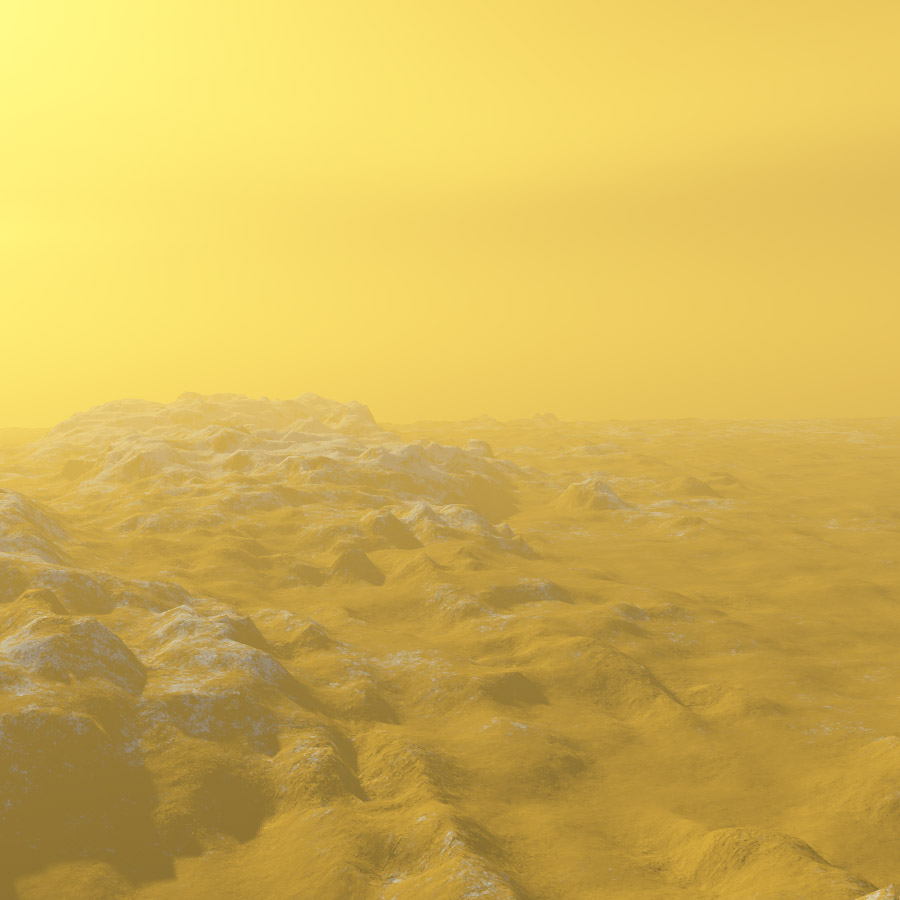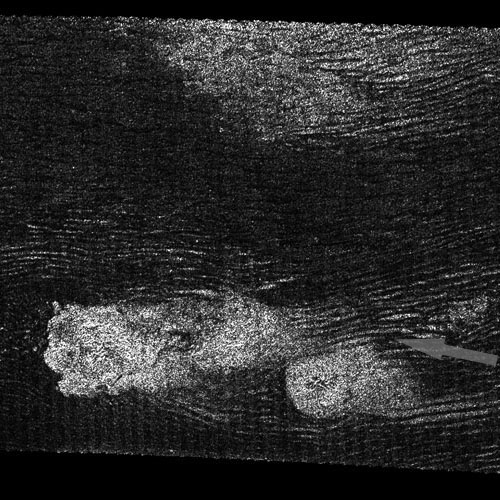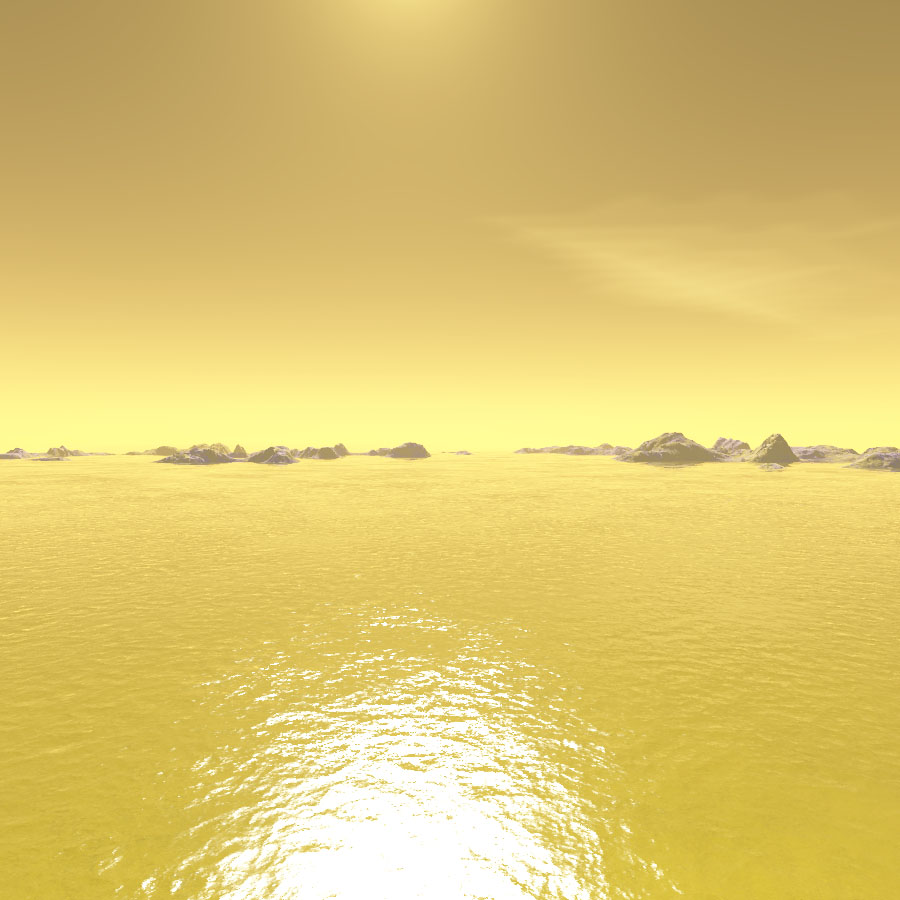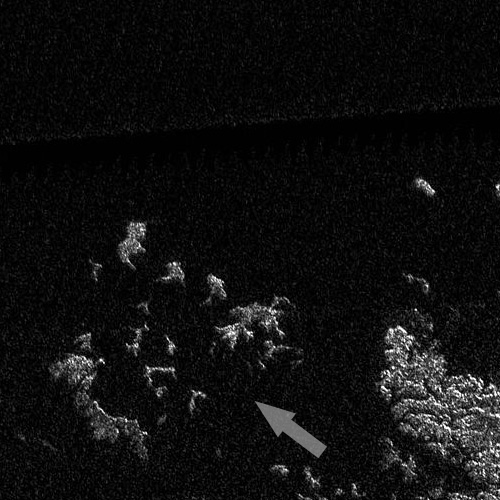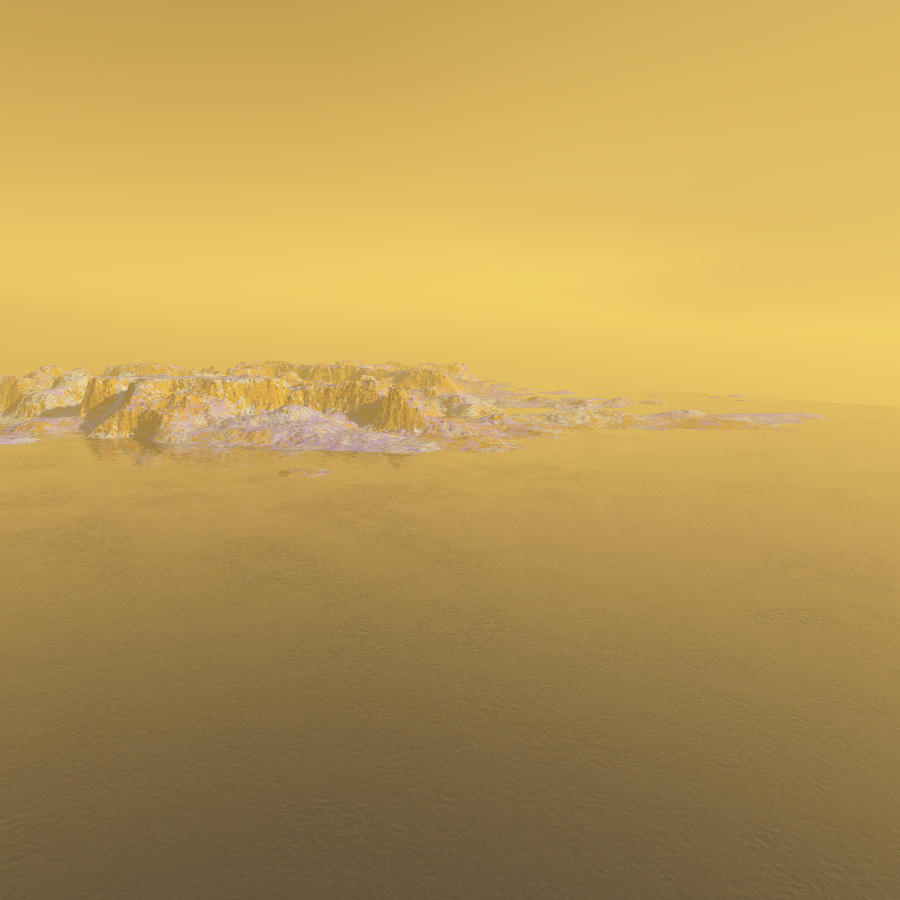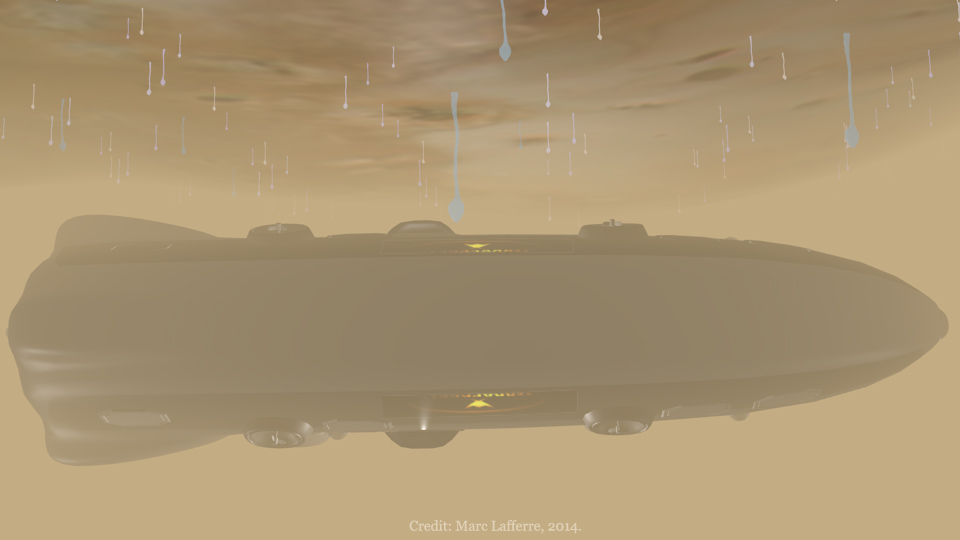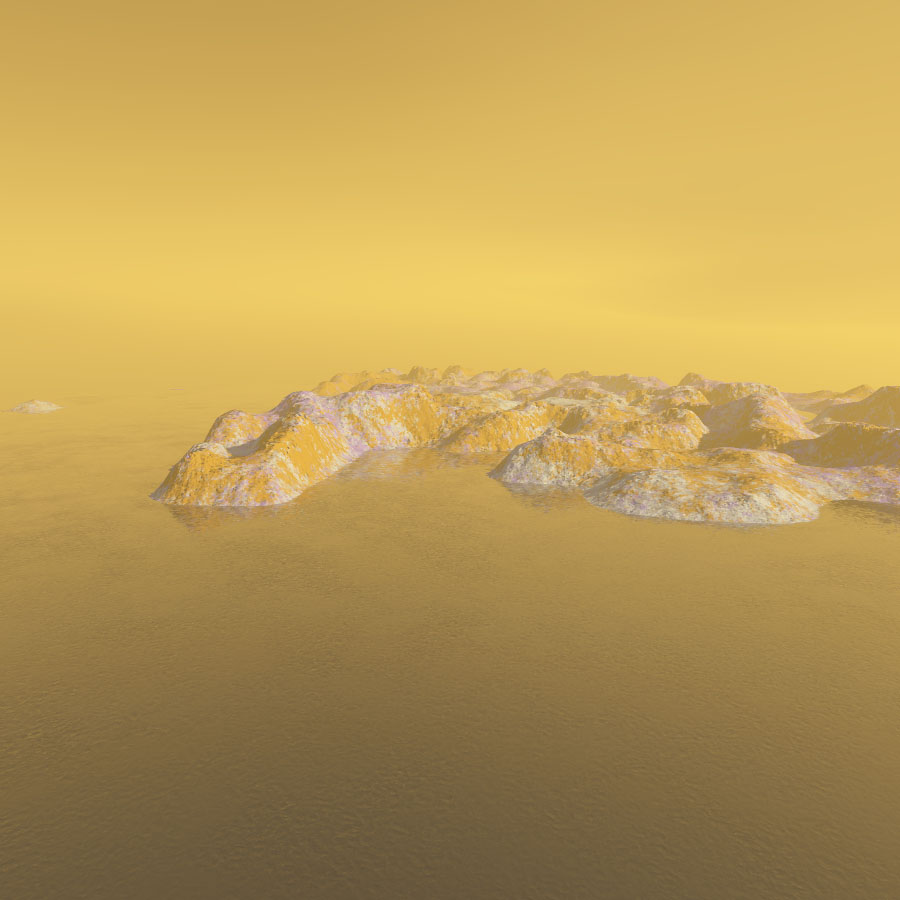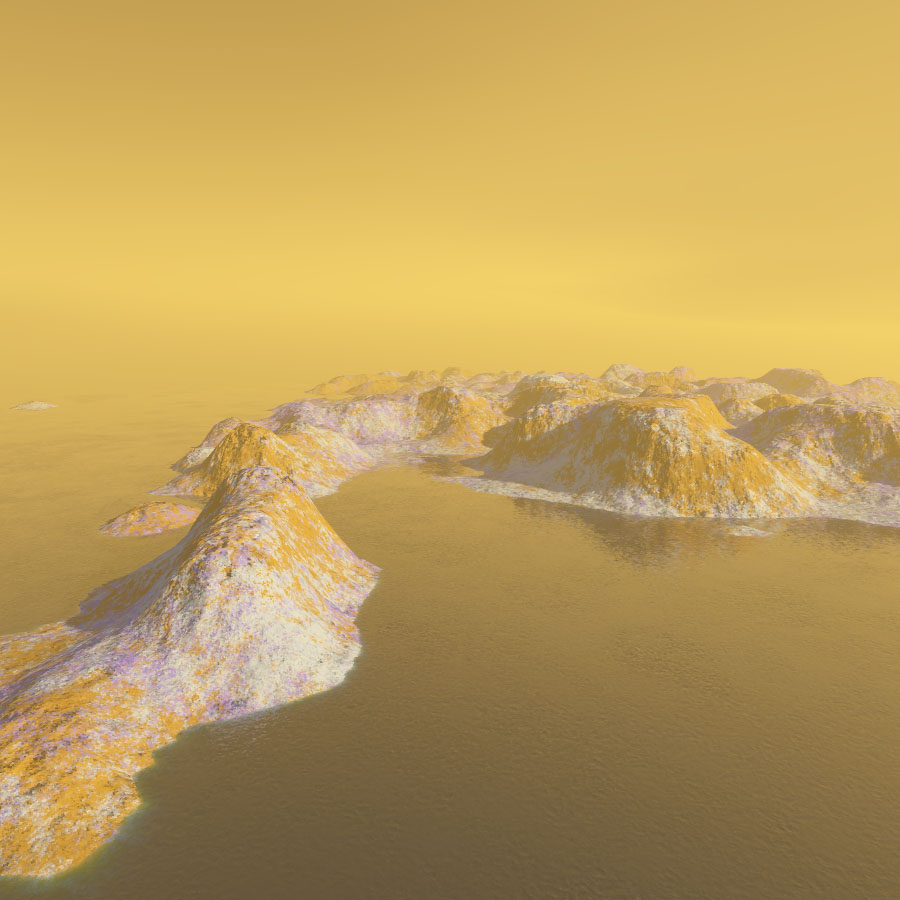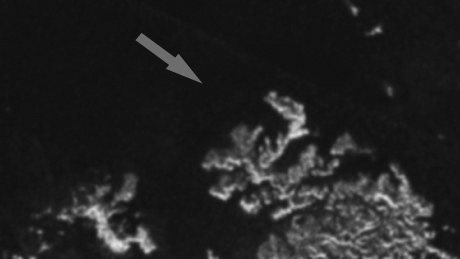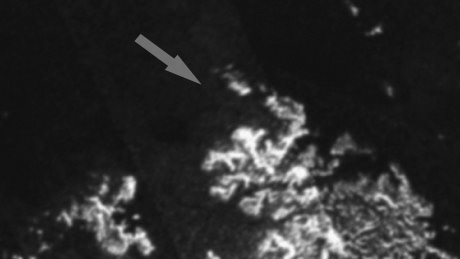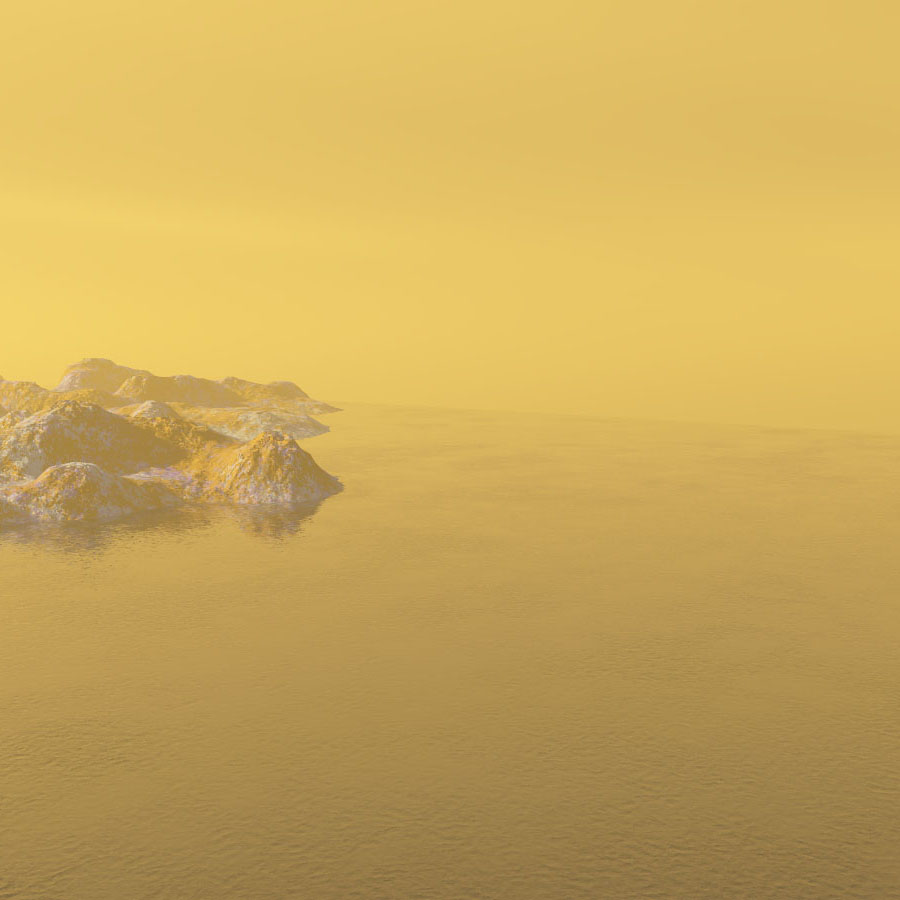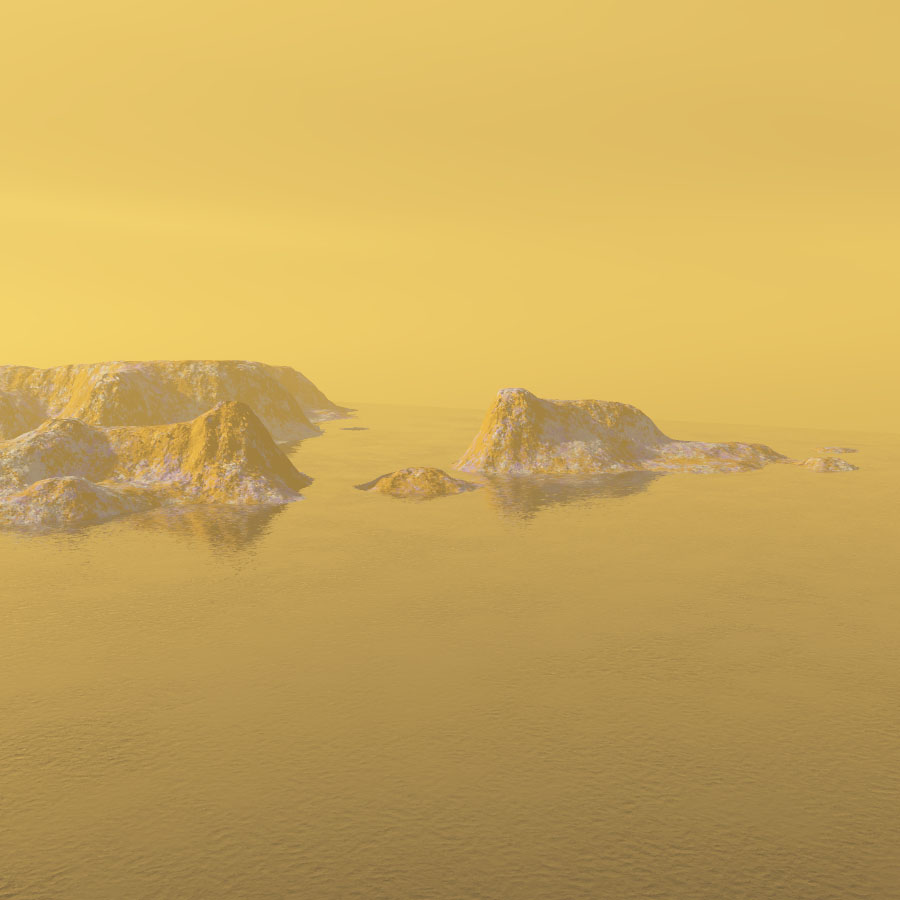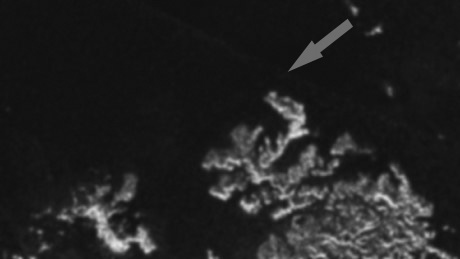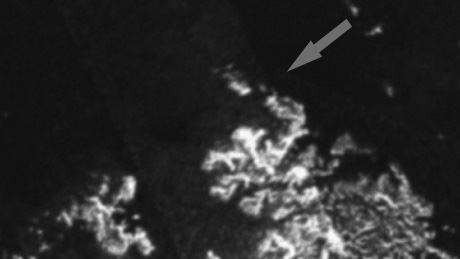Titan News 2014
December 9, 2014: The Shape of Titan's Dunes May Be Closely Related to Strong Winds Blowing Periodically and Rarely From West to East
Saturn's largest moon Titan is well known for its seas, lakes or rivers and for its surprising atmosphere which unveils Familiar processes such as cloud formations or cyclones. Due to the dense and opaque atmosphere of the Orange Moon, the landscape can undergo significant erosional processes. The amount of apparent craters on Titan is relatively low compared to the other moons of the Gas Giant Saturn.
The sand dunes which dominate the dark areas of the low latitudes demonstrate the potential strength of erosional factors such as rainfall, winds or even snowfall. The dunes are mostly concentrated in the equatorial or tropical areas and they have not been observed in the polar areas because the polar areas are particularly damp or humid as the lakes, seas and rivers of methane and ethane show.
The radar data obtained from the Radar Mapper of the Cassini probe since it entered the Saturn System in mid-2004 have clearly revealed the shape of the dunes and have allowed researchers to gather precious information upon the action of prevailing winds. The dune formations appearing in the dark areas of the low latitudes are reminiscent of the Seif Dunes found in the Namib Desert on Earth.
The Seif Dunes identified on Titan tend to extend over long distances and to be parallel and linear as long as they don't encounter any topographic obstacle such as a hill, a mountain, a cliff or an ice chunk. The dunes are sculpted by winds and they can be several hundred yards or meters high, more than a mile wide and hundred of kilometers or miles long.
A new study led by Devon Burr, an associate professor in University of Tennessee's Earth and Planetary Sciences Department reveals that the Titanian winds must blow faster than previously believed to move sand and that the shape of the dunes may be closely related to periodic and rare winds blowing strongly from the west to the east.
The findings, which are presented in the current edition of the journal Nature, are the outcome of a collaboration between Devon Burr, Josh Emery, a UT Earth and Planetary Sciences Assistant Professor, colleagues from the Johns Hopkins University Applied Physics Laboratory, SETI Institute, Arizona State University and the University of California Davis. The work was supported by grants from NASA's Planetary Geology and Geophysics Program and the Outer Planets Research Program.
Devon Burr had been completely astonished, a decade ago, by the famous "Cat Scratches" appearing in the radar views of the low latitudes. The Cat Scratches show that Titan's winds can be strong enough to sculpt the landscape and to form dunes. That's quite surprising to imagine that dunes can form in a harsh environment from the aggregation of tiny particles or organics.
Devon Burr pointed out: "It was surprising that Titan had particles the size of grains of sand -we still don't understand their source- and that it had winds strong enough to move them." She added: "Before seeing the images, we thought that the winds were likely too light to accomplish this movement."
The Cassini researchers took advantage of this remarkable topographic configuration to infer information on the nature of the dunes, on their density and on the movement or the orientation of prevailing winds. The radar data acquired from the Radar Mapper of the Cassini probe had suggested that the predominant winds that sculpted the Seif Dunes blew from east to west. Yet, the way the dune fields were deflected by topographic obstacles like mountains, hills or craters suggested exactly the opposite direction for the winds that is to say from west to east.
In order to determine the way prevailing winds influence the shape of the dunes, Devon Burr started to perform laboratory experiments to simulate the action of winds on different types of sand. She devoted six years to configure a high-pressure wind tunnel from NASA to reproduce the environment of Titan at the level of the ground or the soil.
In order to simulate the dense atmosphere of the Orange Moon, the team of Devon Burr turned up the pressure inside the tunnel. In order to produce the potential winds of Titan, the team turned on the wind tunnel fan. Regarding the enigmatic soil of Titan, the team tried different types of sand to evaluate how they behave under the action of winds.
The nature and the properties of sand have not been precisely determined and the level of uncertainty is high. That's why the team incorporated 23 different varieties of sand into the wind tunnel, the goal being to study how the sand behaves under the action of strong winds.
After two years of work involving the use of multiple models and recalibrations, the team of Devon Burr was able to deduce that the minimum wind on the Orange Moon has to be approximately 50 percent faster than previously believed to move the sand. In other words, the pevious models were probably quite far from reality.
Devon Burr explained: "Our models started with previous wind speed models but we had to keep tweaking them to match the wind tunnel data." She advanced: "We discovered that movement of sand on Titan's surface needed a wind speed that was higher than what previous models suggested."
The team had to take into account, in the experiment, the fact that the atmospheric pressure on the Titanian surface is higher than that of the Earth and that the air is denser than that of the Earth at sea level. Therefore, the team had to perform some tweaking in order to correctly simulate the dynamics of the air on the ground. The finding shows, in a way, that the older models can be used or applied for bodies with thin atmospheres, like comets and asteroids.
The shape of the Titanian dunes is well explained in a configuration in which the threshold for the wind speed is higher than previously thought. Winds blowing from east to west seem to be too weak to shape the Seif Dunes observed with the Radar Mapper.
Devon Burr pointed out: "If the predominant winds are light and blow east to west, then they are not strong enough to move sand." She argued: "But a rare event may cause the winds to reverse momentarily and strengthen."
The atmospheric models predict that wind reverses twice during a full revolution of the Saturn System around the Sun which represents approximately thirty Earth years. The radical change in the orientation of the wind occurs when the Sun goes through the equator engendering a change in the dynamics and in the movement of the atmosphere and the winds. Devon Burr strongly believes, on the basis of her work, that the overall shape of the dunes is sculpted by strong winds blowing from the west to the east during that relatively short period of the Titanian year.
Devon Burr pointed out: "The high wind speed might have gone undetected by Cassini because it happens so infrequently." The evolution in the shape of dunes may tell us more in the coming years, on the basis of radar data, regarding the dynamics and the action of winds. Devon Burr and her collaborators will seize the opportunity of a new grant to study the Titanian winds during different climates on the Orange Moon as well as the effect of electrostatic forces on the sand dynamics.
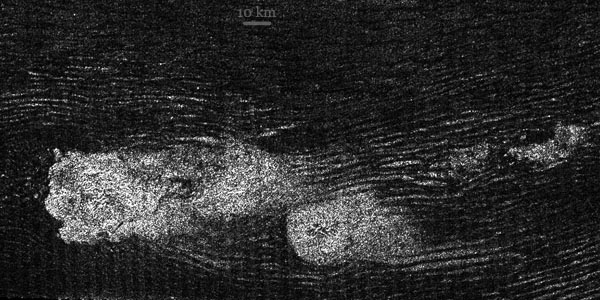
The image above showing the famous Seif Dunes of Titan, deflected or influenced by bright topographic obstacles, hills, mountains or plateaus, corresponds to a portion of a radar view taken from the Radar Mapper of the Cassini probe during the T17 Flyby on September 7, 2006. A scale was incorporated into the original radar image to provide information upon the size of the dunes. Original Image Source: NASA/JPL. Credit for the incorporation of the scale into the original radar view: Marc Lafferre, 2014.
|
|
| The artist's impression shown in the upper part of this
table reveals the famous Seif Dunes found in the low latitudes of the
Opaque Moon Titan. One can observe in the distance a bright hill,
mountain or plateau which tends to deflect the orientation of the Seif
Dunes. The simulated view was obtained on the basis of a radar image
acquired with the Radar Mapper of the Cassini probe during the T17 Flyby
on September 7, 2006. The radar view shown in the lower part of the
table corresponds to the radar image taken during the T17 Flyby. An
arrow was incorporated into the original radar image to show the
orientation of the virtual camera. The artist's rendition was generated
via the Shape From Shading technique. Credit for
the art work: Marc Lafferre, 2014. |
- To get further information on that news, go to: http://tntoday.utk.edu/2014/12/08/ut-research-offers-explanation-titan-dune-puzzle or http://www.astrobio.net/topic/solar-system/saturn/titan/new-study-offers-explanation-titan-dune-puzzle.
November 11, 2014: Radar data Reveal a New Bright Feature in the Largest Sea Kraken Mare and New Altimetry Data Reveal that Kraken Mare Is Significantly Deep
The Cassini researchers continue to try to decipher the nature and the dynamics of Titan's north polar seas and lakes and new clues appear. The finding of a mysterious bright feature dubbed the "Magic Island" in the north polar sea or lake Ligeia Mare has recently been announced. The discoveries continue and a new bright feature identified in the famous north polar sea has just been released. The new bright feature spotted in Kraken Mare may be similar in nature to the "Magic Island" in Ligeia Mare.
In parallel, the Radar Mapper of the Cassini spacecraft has collected altimetry or height data in a delta or near the mouth of a flooded river valley within Kraken Mare. It turns out that Kraken Mare is quite deep. The discoveries are being presented this week at the Division for Planetary Sciences Meeting of the American Astronomical Society taking place in Tucson, Arizona.
Two new bright features close to the coast of Kraken Mare were clearly identified in a Synthetic Aperture Radar (SAR) view obtained with the Radar Mapper of the Cassini probe during the Titan flyby of August 21, 2014. The Cassini researchers performed a comparative analysis of the area on the basis of the radar image of May 23, 2013 and of the radar view of August 21, 2014.
The new bright patches, which are reminiscent of an archipelago, were completely absent in the radar view of May 23, 2013. That's surprising ! And that's not the first time that a bright feature appears in a lake or sea on Titan. Contrary to the "Magic Island" in Ligeia Mare, the intriguing features in Kraken Mare were imaged with the Radar Mapper and with the Visual and Infrared Mapping Spectrometer (VIMS) of the Cassini probe. The data obtained from the VIMS and the radar instrument represent significant clues and scientists are in a position to combine observations taken at two different wavelengths in order to determine the nature of these intriguing bright features.
Is the appearance of the new bright features related to the incidence angle in the radar view ? The radar view of May 23, 2013 where the bright features are absent was obtained with a relatively high incidence angle since it represented 56 degrees. On the other hand, the radar image of August 21, 2014 where the bright features clearly appear was acquired with a relatively low incidence angle since it represented only 5 degrees. The lower the incidence angle, the closer the radar signal is to the normal of the Titanian surface.
Some researchers base their analysis on VIMS data to advance that the new reflective features may correspond to waves, floating debris or a wet ground. They have noted some similarities to features in and around the seas and they consider that the leading hypotheses are the hypothesis for the presence of waves and the hypothesis for the presence of floating debris.
Will the features evolve like the "Magic Island" in Ligeia Mare which may have spread or disintegrated ? Unfortunately, the Titan flyby of August 2014 was the last flyby in which the Radar Mapper acquired data from the largest sea Kraken Mare. But researchers will have a new opportunity in January 2015 to monitor the evolution of the mysterious bright feature in Ligeia Mare, a feature which may be similar in nature to the new bright feature identified in the dark Kraken Mare.
In the Titan flyby of August 2014, the Radar Mapper of the Cassini probe also collected height or altimetry data within Kraken Mare in a delta near the mouth of a wide, flooded river valley along a 120-mile or 200-kilometer shore-to-shore track on the largest north polar sea. The area in which the depth measurements were performed is found in the eastern shoreline of Kraken Mare. The sea's depth was determined for a 25-mile or 40-kilometer band of the data. The way the radar signal bounced off the sea bottom and back to the probe allowed researchers to reveal that the depth ranges from 66 to 115 feet or 20 to 35 meters in that area.
Punga Mare is now the only major lake or sea in the north polar region where no depth measurements have been carried out but altimetry data in Punga Mare are expected to be collected in January 2015. Regarding Kraken Mare, scientists believe that Kraken Mare may be quite deep thanks to altimetry or height data in and around Kraken Mare which unveil relatively steep slopes toward the Sea. Some areas in Kraken Mare didn't reflect any radar signal typical of a radar echo from the seafloor implying that Kraken Mare may be too deep in some areas for the radar signal to penetrate. The darker the lake or sea, the deeper it is supposed to be or the more absorbent or the less reflective it is.
The depth and the nature of the liquid play a key role in the way the lake or sea will appear in radar images. Kraken Mare, Ligeia Mare and Punga Mare are likely mostly composed of methane and ethane. Some methane clouds have been clearly identified over Ligeia Mare, recently. The seasonal factors may play a key role in the dynamics of the north polar lakes, seas and rivers. That's why researchers pay a special attention to the north polar region where the Summer season is approaching.
Will the level of the north polar lakes or seas decrease or increase in the coming Terrestrial years ? Is there cryovolcanism in the area and are there methane or ethane reservoirs beneath the icy crust ? How can we explain the dichotomy in the distribution of lakes and seas between the north polar region and the south polar region ? The bright features which seem to have appeared in Ligeia Mare and Kraken Mare bring new questions and hypotheses. Can the bright features be the outcome of snow fall of hydrocarbons or organics ? Can they be the outcome of rising bubbles related to hot springs or a volcano ? Or can they represent microorganisms rising to the surface of the lake or sea ? The debate is opened.
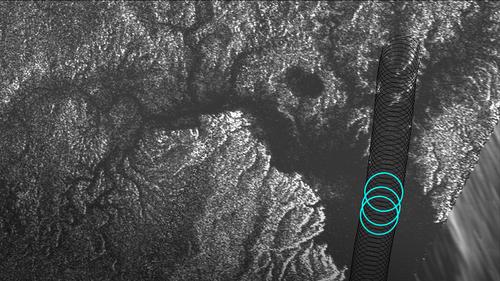
The image above corresponds to a radar view of Kraken Mare obtained on August 21, 2014 from the Radar Mapper of the Cassini probe. The three blue circles reveal the places where the altimetry measurements were performed. The researchers were able to determine that the area of the first circle, from the left, represents a depth of 89 feet or 27 meters, that the area of the second circle represents a depth of 108 feet or 33 meters and that the area of the third circle represents a depth of 98 feet or 30 meters. Image Credit: NASA/JPL-Caltech/ASI/Cornell.
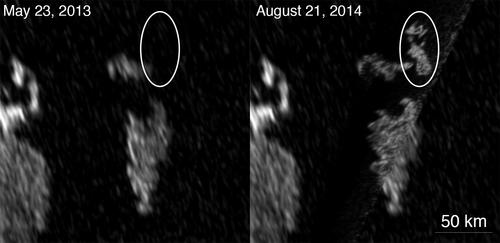
The radar mosaic above unveils the area of Kraken Mare where a new bright feature or a new island has been found in the radar view of August 21, 2014 obtained from the Radar Mapper of the Cassini spacecraft. This intriguing feature was completely absent in the radar image of May 23, 2013. Is this bright feature related to waves, floating debris, snow fall or cryovolcanism ? Image Credit: NASA/JPL-Caltech/ASI/Cornell.
- To get further information on that news, go to: http://saturn.jpl.nasa.gov/news/cassinifeatures/feature20141110.
October 31, 2014: VIMS Data Reveal a Sunglint and a Spectacular Environment in the Titanian North Polar Sea Kraken Mare
A spectacular view of Titan's north polar region based on infrared data obtained with the Visual and Infrared Mapping Spectrometer of the Cassini probe has just been released. The infrared data were acquired on August 21, 2014 during the T104 flyby of Titan as the Cassini spacecraft soared past the Opaque Moon. This is the first time that researchers acquire, at the same time, a view of the north polar seas or lakes and a sunglint or a specular reflection in a polar sea or lake.
The view of Titan's disk corresponds to a near-infrared color mosaic of Titan's north polar region based on real color data. However, the colors shown here don't represent the natural colors the human eye would see due to its particular spectral sensitivities. The haze or the opaque atmosphere of the giant moon prevents the outer space observer from discerning surface features. The surface can be clearly seen in the infrared or near-infrared spectrum. In the spectacular view of the Titanian globe, red corresponds to 5.0 microns, green to 2.0 microns and blue to 1.3 microns.
The sunglint, the specular reflection or the mirror-like reflection, also known as a specular point, can be found in the upper left part of the disk in the largest surface body of liquids known as Kraken Mare. The sunglint appears, precisely, in the south of the famous sea, just north of an island archipelago representing a natural boundary between the portion of the sea found in the south and the upper portion of the sea.
One can point out that the specular point or the mirror-like reflection was particularly bright so that it saturated the detector of the VIMS instrument of the Cassini probe which acquired the image. The specular reflection was observed with the highest observation elevation so far since the Sun appeared completely at an angle of 40 degrees above the horizon as observed from Kraken Mare at the time of the observation. That's much higher than the 22 degree angle in the configuration of the well-known view PIA18433 which unveiled the first clear specular reflection identified in the north polar region.
The sunglint or the mirror-like reflection was so bright that it was visible through the atmosphere or the haze at much lower wavelengths than before, down to 1.3 microns. The composite view of Titan's disk shows several interesting features such as the sunglint in Kraken Mare, the bright shoreline in the south of Kraken Mare and an arrow-shaped feature in the area of Ligeia Mare, a major lake or sea in the north polar region.
The bright rims in the southern portion of Kraken Mare can be found in the upper left part of the disk. The bright shoreline may be related to evaporate deposits and may reveal that the sea may have been larger at some point in the past. In other words, relatively recently, there may have been strong net evaporation processes in the area accounting for the apparent decrease in the level of the sea and the development of a bright shoreline in the south of Kraken Mare, in particular. The bright deposits which result from the presumed evaporation process of methane and ethane from the sea may be reminiscent of the saline crust on a typical salt flat.
The resolution of the global view is not homogeneous. The highest resolution data in the T104 flyby of the Orange Moon can be found immediately to the right of the sunglint where one can identify the labyrinth of channels connecting the pools of hydrocarbons Kraken Mare and Ligeia Mare. An arrow-shaped feature can be clearly observed in the northern part of Ligeia Mare. The bright patches of this arrow-shaped feature correspond, in fact, to clouds of liquid methane droplets.
That's the sign that there is a methane cycle in this area with evaporation, condensation and precipitation processes similar to the water cycle occuring on Earth. The area may be particularly dynamic over a Titanian year which lasts about 29.5 Terrestrial years. Is there a growing net evaporation in the area as the Summer season in the northern hemisphere approaches ? Does the arrow-shaped cloud system identified over Ligeia Mare bring rainfall ?
Prior to the landing of the Huygens probe in the Adiri/Shangri-La region on January 14, 2005, some scientists believed that the dark regions of the low latitudes in the infrared or near-infrared views of Titan represented seas or oceans of methane. We know, now, that the less reflective or low-albedo areas in the equatorial or tropical regions are dominated by great fields of sand dunes, Seif dunes or linear and parallel dunes extending over long distances.
The damp areas appear to be found in the polar regions as the VIMS or radar images clearly show. Currently, the north polar region appears to be damper than the south polar region. Kraken Mare, Ligeia Mare and Punga Mare turn out to be the largest pools of liquids in the north polar region. Ontario Lacus, which was the first lake or sea clearly identified on Titan, is the major lake or sea in the south polar region.
Some researchers believe that the level of the lakes or seas in the south polar region tends to be higher during the Winter season than during the Summer season, simply because of a colder environment which favors condensation processes of methane. The moisture dichotomy between the south polar area and the north polar area is not well understood even if orbital parameters such as the variation in the distance from the Sun or the variation in the amount of solar energy may account for this surprising dichotomy.
Like the rotation axis of the Earth, the rotation axis of Titan is inclined significantly to the normal of its orbital plane and the orbit of the Saturn system around the Sun is elliptical. When Titan is closer to the Sun, the solar energy reaching the atmosphere is higher and it has an influence on the climate or meteorology, in particular in the polar areas. And the season plays a significant role, of course.
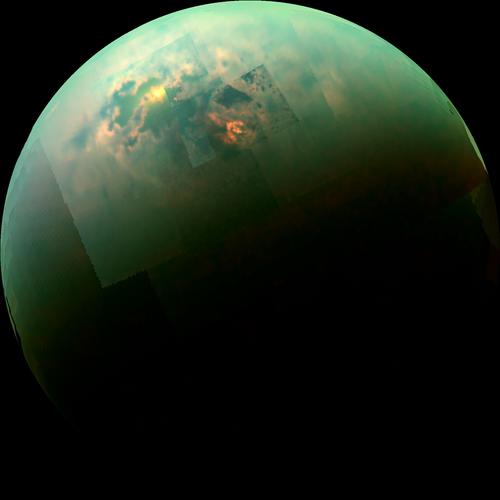
The image above corresponds to the composite view unveiling the sunglint of August 21, 2014. The mirror-like reflection occuring in the north polar sea Kraken Mare was taken with the VIMS instrument of the Cassini probe in the near-infrared spectrum. Image Credit: NASA/JPL-Caltech/Univ. Arizona/Univ. Idaho.
|
|
| The artist's impression of the upper part of the table
represents a simulated view of Kraken Mare, the largest pool of liquids
in the north polar region of Titan. In the lower part of the table, the
grey arrow incorporated into the original radar view of Kraken Mare,
obtained on May 12, 2007 with the Radar Mapper of the Cassini probe,
shows the orientation of the virtual camera. The artist's impression was
generated on the basis of the "Shape From Shading" technique. Several
islands can be clearly seen in the simulated image. The Sun appears here
at an angle of 40 degrees above the horizon.
Credit for the artist's impression:
Marc Lafferre, 2014. |
- To get more information on that news, go to: http://saturn.jpl.nasa.gov/news/newsreleases/newsrelease20141030.
October 24, 2014: NASA Researchers Identify a Methane Ice Cloud in the Stratosphere of Titan's North Polar Region And the ALMA Reveals that the Distribution of some Organic Molecules in Titan's Atmosphere Is Surprisingly Skewed From the Poles
Researchers from NASA have determined that a giant high-altitude or stratospheric cloud they had spotted over Titan's north polar region eight years before is composed of methane ice. They were surprised to find methane clouds in the Stratosphere since most of the meteorological processes are supposed to occur in the Troposphere.
The polar stratospheric clouds are also found on Earth but, of course, they don't contain methane ice. Methane ice generates a much denser cloud than the ethane ice which had already been found at a high altitude above Titan's north polar region.
Carrie Anderson, a Cassini participating scientist at NASA's Goddard Space Flight Center in Greenbelt, Maryland, and lead author of the study available online in the journal Icarus pointed out: "The idea that methane clouds could form this high on Titan is completely new."... She added: "Nobody considered that possible before."
The polar regions of Titan are composed of lakes, seas and rivers and the Cassini scientists have clearly shown that tropospheric methane clouds form and produce rainfalls. The methane cycle on Titan is similar to the water cycle on Earth. There are evaporation processes and condensation processes because the decrease in environmental temperature as the altitude increases will imply methane cloud formation. The clouds of methane vapor or methane ice can engender precipitation processes, rainfall or snow fall.
The stratospheric methane cloud identified over Titan's north polar region is reminiscent of the Terrestrial polar stratospheric clouds which tend to take shape above the North Pole and South Pole between 49,000 and 82,000 feet or between 15 and 25 kilometers above the ground. In fact, these rare clouds can only form if the environmental temperature falls to minus 108 degrees Fahrenheit or minus 78 degrees Celsius.
Several types of stratospheric clouds had already been found on the Opaque Moon. The researchers had determined that the giant ice cloud engulfing the north polar region, which was experiencing the Winter period at the time of the observation, was composed of ethane. One can say that a diffuse cloud of ethane resulting from chemical recombination after methane breaks down has been spotted. Under the action of ultraviolet light from the Sun, methane molecules tend to be destroyed and new molecules or new clouds form. Some clouds composed of cyanoacetylene and hydrogen cyanide, produced from reactions of methane byproducts with nitrogen molecules have also been identified.
Most of the moisture or the methane is trapped in Titan's Troposphere where upward or downward movements occur. Above the Troposphere, in the Stratosphere, the environment is colder and the movements tend to be parallel to the ground. The ice clouds in the Stratosphere can only form if the environment is extremely cold. For instance, the Cassini probe had revealed a stratospheric temperature of minus 333 degrees Fahrenheit or minus 203 degrees Celsius just south of the equator which is not cold enough to allow the relatively scarce amount of methane molecules in the environment to condense into ice.
Carrie Anderson and her Goddard co-author Robert Samuelson had noticed, on the basis of data from Cassini's Composite Infrared Spectrometer and from Cassini's Radio Science Instrument, that temperatures in the lower Stratosphere depend on the latitudes and that the high-altitude temperature near the north pole was much lower than that just south of the equator. The environmental temperature difference between these particular areas appears to represent as much as 11 degrees Fahrenheit or minus 12 degrees Celsius which is largely enough to allow the presence of methane ice or the formation of methane ice clouds in the Stratosphere above the north polar area.
The initial analysis of the north polar cloud system found high above the ground concluded that the cloud was composed of small particles of ethane ice but later observations showed clumpier and denser areas which implies that more than one type of ice could be found. The Cassini researchers have been in a position to determine that the larger molecules are the right size to correspond to methane ice and that their proportion in the environment of the lower-polar Stratosphere, representing about one-and-a-half percent, is enough to allow the formation of ice particles.
Like in the atmosphere of the Earth, convection cells take shape in the atmosphere of Titan. In the global circulation pattern of the Orange Moon, warm air in the Summer hemisphere goes up from the surface and reaches the Stratosphere. This air then goes toward the Winter pole where the environmental temperature is lower. At the level of the Winter pole, the air mass tends to go down and cool. The cooling process makes it possible for stratospheric methane clouds to take shape.
Michael Flasar, Goddard scientist and principal investigator for Cassini's Composite Infrared Spectrometer (CIRS) advanced: "Cassini has been steadily gathering evidence of this global circulation pattern, and the identification of this new methane cloud is another strong indicator that the process works the way we think it does."
Carrie Anderson and Robert Samuelson have been in a position to determine that this type of methane ice cloud system, also known as Subsidence-Induced Methane Cloud or SIMC, could form between 98,000 to 164,000 feet or 30 to 50 kilometers in altitude above the ground of the Opaque Moon. A parallel between the location of Earth's stratospheric clouds and the location of this methane cloud has been drawn. This methane cloud has been observed near the Winter pole, above 65 degrees north latitude.
Scott Edgington, Cassini deputy project scientist at NASA's Jet Propulsion Laboratory in Pasadena, California pointed out: "Titan continues to amaze with natural processes similar to those on the Earth, yet involving materials different from our familiar water."... He concluded: "As we approach southern winter solstice on Titan, we will further explore how these cloud formation processes might vary with season."
The observation of the methane ice cloud above the north polar region shows that the meteorology on Titan is particularly complex with evaporation, condensation and precipitation processes as well as rainfall of methane or ethane and snow fall.
A new study recently published online in the Astrophysical Journal Letters and led by Martin Cordiner, an astrochemist working at NASA's Goddard Space Flight Center in Greenbelt, Maryland, reveals that some organic molecules present in the Titanian atmosphere are surprisingly skewed from the poles. At high altitudes, the distribution of some particular organic molecules from the poles is irregular. Yet, the windy atmosphere and the strong currents parallel to the equatorial line should engender the elimination of such off-axis concentrations.
Martin Cordiner argued: "This is an unexpected and potentially groundbreaking discovery." He added: "These kinds of east-to-west variations have never been seen before in Titan's atmospheric gases. Explaining their origin presents us with a fascinating new problem."
The finding upon this irregular atmospheric concentration was made possible thanks to a remarkably short three-minute "snapshot" observation with the Atacama Large Millimeter/submillimeter Array or ALMA. Some interactions between the energy from the Sun, the magnetic field from Saturn and the atmosphere of Titan occur engendering new molecules and organic molecules in particular. The chemical processes in Titan's atmosphere may resemble the chemical processes occuring in the atmosphere of the early Earth.
The ALMA which has an extreme sensitivity and resolution has allowed scientists to determine the atmospheric distributions of hydrogen isocyanide (HNC) and cyanoacetylene (HC3N) which initially appeared to be concentrated evenly or homogeneously above Titan's north and south poles. These discoveries were in line with Cassini observations.
However, the comparison of gas concentrations at different atmospheric levels revealed that, at the highest altitudes, the pockets of organic compounds were shifted away from the poles. That's surprising or intriguing because the fast-moving, east-west winds in the middle atmosphere should progressively mix the molecules taking shape in the environment.
Conor Nixon, a planetary scientist at Goddard and a coauthor of the study pointed out: "It seems incredible that chemical mechanisms could be operating on rapid enough timescales to cause enhanced 'pockets' in the observed molecules."... He added: "We would expect the molecules to be quickly mixed around the globe by Titan's winds."
This skewed molecular concentration from the poles may be related to thermal factors and to the influence of the magnetic field of Saturn which reaches the orbit of Titan. Martin Cordiner advanced: "Alternatively, I don't think we could rule out some kind of peculiar atmospheric circulation pattern." The thick and opaque atmosphere of Titan is mostly composed of nitrogen and methane but more complex compounds such as ethane or propane can also be found in smaller proportions.
Anthony Remijan, an astronomer at the National Radio Astronomy Observatory in Charlottesville, Va., and coauthor of the study advanced: "These ALMA observations give us new insights into how organic molecules, the building blocks of life, form and evolve in a planet-like environment." He concluded: "It is exciting to imagine the new discoveries ALMA will enable as we look more deeply at other interesting objects in our Solar System."
The ALMA observations of HNC and HC3N in Titan's atmosphere show that there are some irregular extensions of their concentration from the poles where they tend to be denser or more concentrated. The distribution of HNC from the poles, in the upper atmosphere, is particularly irregular. The distribution of HC3N in the upper atmosphere is also skewed but its concentration is more homogeneous or less heterogeneous. However, the ALMA image of the intermediate-to-lower elevations in the Titanian atmosphere shows that HC3N is oriented more evenly or more concentrated about the poles than at higher altitudes.
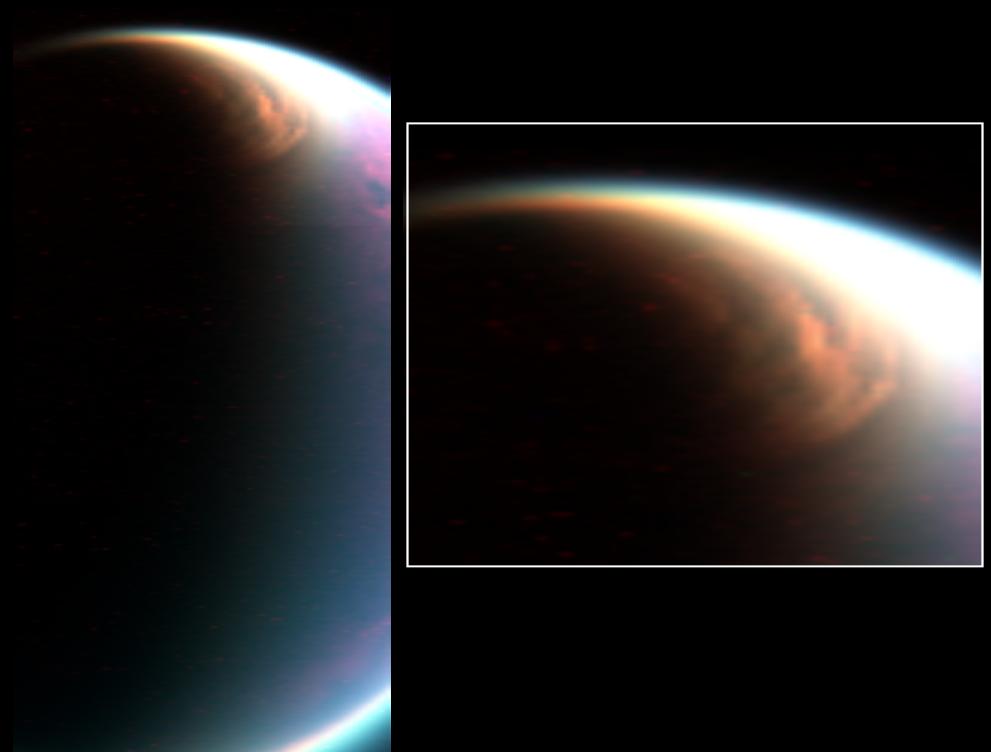
The composite view above generated on the basis of a an image obtained with the Visual and Infrared Mapping Spectrometer of the Cassini probe on December 29, 2006 unveils the famous high-altitude cloud which was engulfing the north polar region during the Winter season. The Cassini researchers had determined that the high-altitude cloud was made up of ethane. Surprisingly, NASA researchers have shown that the stratospheric polar cloud is composed of methane ice. Image Credit: NASA/JPL/University of Arizona/LPGNantes.
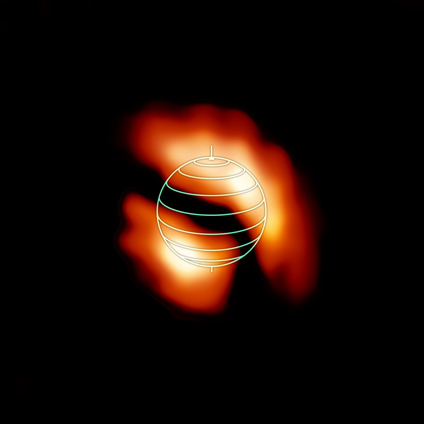 |
The left view corresponds to an ALMA image showing the distribution of the organic compound HNC in the upper atmosphere of the Opaque Moon Titan. One can notice that the denser or brighter concentrations of the molecule are found in the polar areas and that the distribution of HNC in the upper atmosphere is surprisingly skewed from the poles. Image Credit: NRAO/AUI/NSF; M. Cordiner (NASA) et al. |
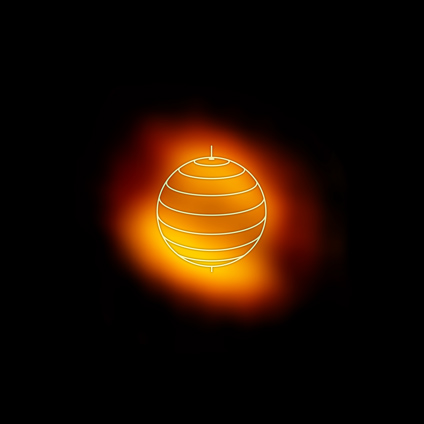 |
The left image corresponds to an ALMA view revealing the distribution of the organic compound HC3N in the upper atmosphere of the Orange Moon Titan. One can notice that the denser or brighter concentrations of the compound are found in the polar regions and that the distribution of HC3N is remarkably skewed from the poles. However, the distribution of HC3N in the upper atmosphere appears to be less heterogeneous than HNC. Image Credit: NRAO/AUI/NSF; M. Cordiner (NASA) et al. |
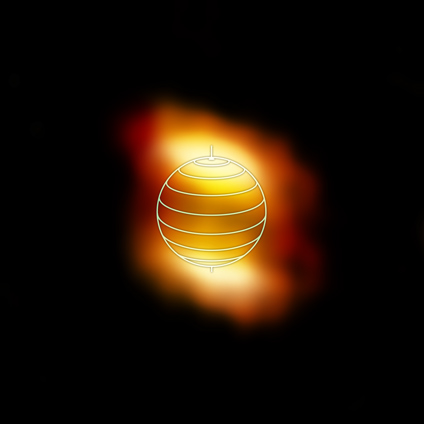 |
The left view corresponds to an ALMA image unveiling the distribution of HC3N at intermediate-to-lower altitudes in the atmosphere of Saturn's largest moon Titan. One can notice that the denser or brighter concentrations of HC3N are found in the polar areas and that the distribution of HC3N is intriguingly skewed from the poles. This view shows that HC3N appears to be more concentrated in the intermediate to lower altitudes of the poles than in the upper atmosphere of the poles. Image Credit: NRAO/AUI/NSF; M. Cordiner (NASA) et al. |
- To get more information on that news, go to: http://saturn.jpl.nasa.gov/news/cassinifeatures/feature20141024 and https://public.nrao.edu/news/pressreleases/organic-molecules-titan.
October 3, 2014: A New Study Reveals that the High-Altitude South Polar Vortex of Titan is Cold and Toxic
The atmosphere of Titan appears complex and dynamic. Large cloud systems developing in the high latitudes of the southern hemisphere have been frequently observed, for instance, during the Summer season. The Summer season came to an end in August 2009 in the southern hemisphere. The area is now experiencing the Autumn season and a new atmospheric phenomenon is drawing the attention of scientists. A high-altitude vortex or cyclone is hovering over the southern polar region. The bright or yellow vortex was first identified in May 2012 from the Visual and Infrared Mapping Spectrometer of the Cassini probe.
The emergence of this giant vortex or swirling cloud may be closely related to changing season as the Autumn season brings lower environmental temperatures. The Cassini researchers have been in a position to determine that the giant polar vortex is composed of frozen hydrogen cyanide, a toxic molecule whose chemical formula is HCN. Condensation phenomena may have occured following a dramatic cooling of the atmosphere in the southern polar area.
Remco de Kok of Leiden Observatory and SRON Netherlands Institute for Space Research, lead author of the study published recently in the journal Nature pointed ou: "The discovery suggests that the atmosphere of Titan's southern hemisphere is cooling much faster than we expected."
Researchers become aware that significant changes can occur in the atmosphere of Titan due to seasonal changes. Significant atmospheric changes can occur because the inclination of the rotational axis of Titan to the normal of its orbit is relatively high and because the distance between Titan and the Sun can vary significantly during the elliptical orbit of the Saturn system around the Sun.
A year on Titan lasts approximately 29.5 Terrestrial years and each season lasts approximately seven Terrestrial years. The Summer season in the southern hemisphere and the Winter season in the northern hemisphere came to an end in August 2009 with the start of the Spring season in the northern hemisphere and of the Autumn season in the southern hemisphere. The Winter season in the southern hemisphere is now approaching as its start will occur in 2017. Will the southern polar vortex continue to develop as environmental temperatures progressively decrease ?
The observation of May 2012 reveals that the vortex is relatively big and high in altitude. Its diameter is several hundred miles. Researchers are surprised by the relatively high altitude of the vortex or cyclone which is found at about 200 miles or 300 kilometers over Titan's surface. They believed that the temperature was too warm or not cold enough for clouds to form. Remco de Kok underlined: "We really didn't expect to see such a massive cloud so high in the atmosphere."
Thanks to spectroscopy, the Cassini researchers have been able to determine the particular composition of the vortex. They split the spectrum of sunlight reflected by the Titanian atmosphere to identify the different elements or molecules present in the atmosphere. The Visual and Infrared Mapping Spectrometer of the Cassini spacecraft can see in the infrared or near-infrared through the opaque atmosphere of the Orange Moon up to the surface.
The VIMS can map the distribution of chemical compounds in the atmosphere and on the ground. Thus, we know that the atmosphere is mostly composed of molecular nitrogen and methane. Some clouds can be composed of methane or ethane but the southern polar vortex has a more exotic composition. Remco de Kok explained: "The light coming from the polar vortex showed a remarkable difference with respect to other portions of Titan's atmosphere." He added: "We could clearly see a signature of frozen HCN molecules."
Researchers knew that HCN is present in small amounts in Titan's atmosphere but they didn't expect to find HCN in the form of ice in the upper atmosphere over the southern polar region. In fact, HCN or hydrogen cyanide can condense to form frozen molecules only if the atmospheric temperature goes down as low as minus 234 degrees Fahrenheit or minus 148 degrees Celsius. Current theoretical models of the upper atmosphere of the Orange Moon didn't predict atmospheric temperatures as low as that. Atmospheric temperatures approximately 200 degrees Fahrenheit or 100 degrees Celsius higher had been anticipated by the models preventing the possibility of HCN condensation and freezing.
The Cassini scientists resorted to data from the Composite Infrared Spectrometer (CIRS) of the Cassini probe in order to get key data on atmospheric temperature at different altitudes and to check whether the atmospheric temperature was low enough for HCN to turn into ice. The CIRS data reveal that the southern hemisphere of the Orange Moon has been cooling rapidly and that the atmospheric temperature has reached the threshold from which HCN turns into ice and the giant toxic vortex can take shape over the southern polar region.
The seasonal changes imply atmospheric movements due to thermal changes. Since the new season in 2009, large masses of gas have been attracted towards the south and the decrease in atmospheric temperature over the southern polar region has allowed HCN, which was more concentrated in the area, to condense and freeze to form the observed vortex. HCN molecules shine brightly at infrared wavelengths because they are more concentrated and this phenomenon tends to cool the surrounding air, making it possible for molecules to condense.
The cooling or the decrease in temperature over the southern polar region is the consequence of the more diffused or reduced solar energy reaching the southern hemisphere as Autumn develops and Winter approaches. That's why one may reasonably anticipate a development of the southern polar vortex in the coming Terrestrial years.
Earl Maize, Cassini project manager at NASA's Jet Propulsion Laboratory in Pasadena, California pointed out: "These fascinating results from a body whose seasons are measured in years rather than months provide yet another example of the longevity of the remarkable Cassini spacecraft and its instruments." He concluded: "We look forward to further revelations as we approach summer solstice for the Saturn system in 2017."
We know, now, that different kinds of clouds can take shape in the atmosphere of Titan, from clouds of methane or ethane to clouds of hydrogen cyanide at higher altitudes. Thanks to the remarkable longevity of the instruments of the Cassini probe, we get, every Terrestrial year, significant clues on the seasonal dynamics and on the meteorology of Titan's atmosphere. Will the lakes or seas in the south polar region see their level increase in the coming Terrestrial years as the Winter season approaches and develops ? That's one of the big questions regarding the meteorology in the southern polar region.
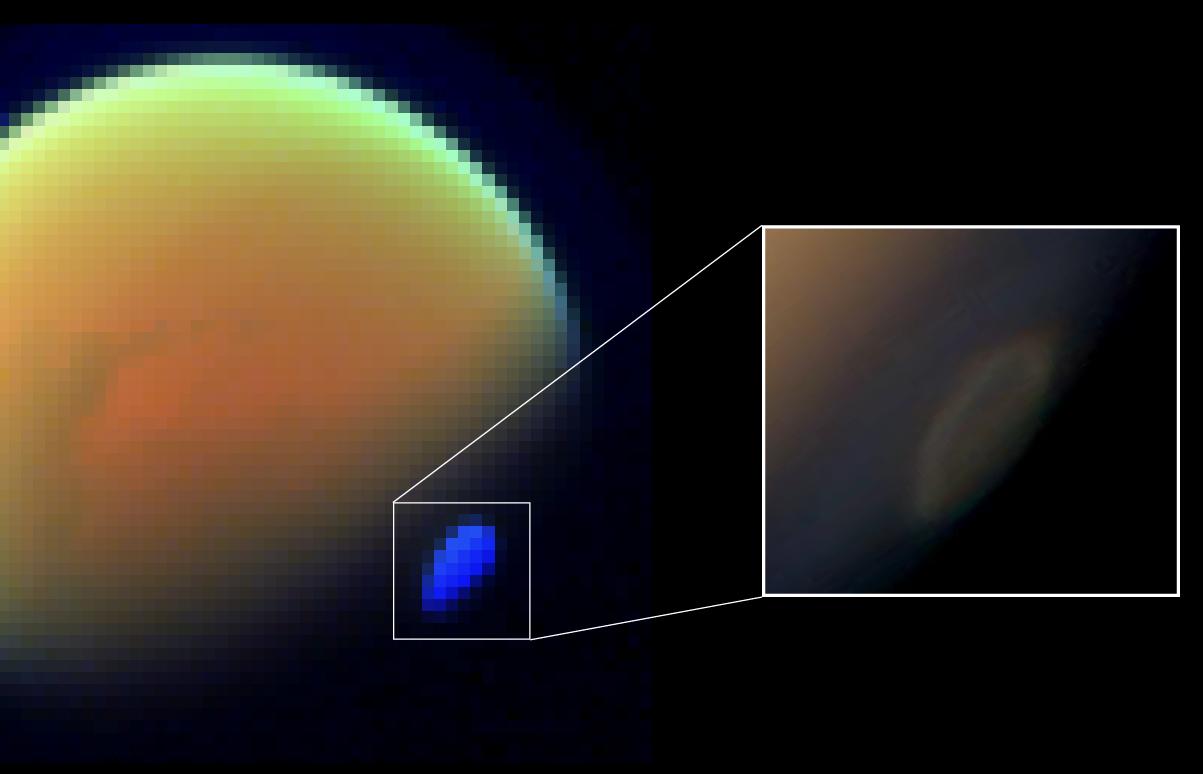
The mosaic above shows the famous vortex found at a particularly high altitude above the southern polar region of Saturn's largest moon Titan. The image on the left corresponds to a spectral map of the Opaque Moon taken, with the Visual and Infrared Mapping Spectrometer or VIMS of the Cassini probe on November 29, 2012. The vortex, appearing in blue here, is composed of HCN. The view on the right, centered on this yellowish vortex, corresponds to a portion of an image acquired on July 25, 2012 with the Wide-Angle Camera of the Cassini spacecraft. Image Credit: NASA/JPL-Caltech/ASI/University of Arizona/SSI/Leiden Observatory and SRON.
- To get further information on that news, go to: http://saturn.jpl.nasa.gov/news/newsreleases/newsrelease20141001.
September 30, 2014: A New Radar View of Titan Obtained on August 21, 2014 Shows that the Enigmatic "Magic Island" Is Changing in terms of Shape, Size and Appearance
The north polar lakes and seas of Titan continue to fascinate and intrigue the Cassini researchers. Lakes, seas, rivers, islands, bays or peninsulas can be found in the exotic environment of the high latitudes of the northern hemisphere. A new radar image of a particular area in the famous lake or sea Ligeia Mare confirms the presence of a dynamic topographic feature. This feature had been dubbed the "Magic Island" on the basis of a previous radar view because it appeared as a bright patch inside the dark and uniform Ligeia Mare.
The north polar region of the Opaque Moon appears to be the dampest area on Titan with three major bodies of surface liquids, Kraken Mare, Ligeia Mare and Punga Mare. The lakes, seas and rivers are likely composed of a mixture of methane and ethane. A methane cycle comparable to the water cycle on Earth takes shape in the area. This methane cycle involves evaporation processes, condensation processes, cloud formation and precipitation processes.
The intriguing bright feature or the Magic Island was first identified in a radar view obtained on July 10, 2013 from the Radar Mapper of the Cassini probe during a flyby of Titan. The researchers deduced that it was a new topographic feature because it was simply absent in the previous radar data taken on April 26, 2007 with the Radar Mapper of the Cassini spacecraft. The radar view acquired on April 26, 2007 from the orbiter clearly shows that the area of the Magic Island is uniformly dark.
The Synthetic Aperture Radar (SAR) data of the area taken from 2007 to 2009 hadn't unveiled any sign of topographic changes in the area of Ligeia Mare where the "Magic Island" would emerge. The phenomenon is really surprising and intriguing because the images obtained from the Visual and Infrared Mapping Spectrometer of the Cassini probe after the radar view of July 10, 2013, later in July and in September 2013, didn't reveal the presence of the intriguing feature. And low-resolution SAR views acquired in October 2013 from the Cassini spacecraft also failed to detect or identify the enigmatic feature.
Therefore, some researchers came to the conclusion that the Magic Island might have been a transient feature. However, a new radar image taken during the flyby of August 21, 2014 reveals that the enigmatic feature is still there, that it was not an artifact or a flaw in the Cassini data and that the appearance of the intriguing feature has significantly changed during the 11 months since it was last observed.
The Magic Island doesn't look like an island anymore since it seems to be diffused with scattered parts and poorly reflective. The feature which appeared irregular and particularly bright in the radar image of July 10, 2013 has apparently extended and doubled in size from approximately 30 square miles or 75 square kilometers in the radar view of 2013 to about 60 square miles or 160 square kilometers in the radar view of August 21,2014.
Brighter areas will tend to be higher in elevation. Peaks, mountains or hills will tend to have a bright radar signature and plateaus or plains will tend to have a weaker or darker radar signature. The Magic Island observed in the radar view of July 10, 2013 shows a strong radar signal or a high brightness level which may imply the presence of a mountain or a volcano.
If this hypothesis is correct, the volcano or cryovolcano may have been significantly eroded or may have significantly dissolved since the observation of July 10, 2013 as the radar image of August 21, 2014 suggests. In the radar image of August 21, 2014, the Magic Island or the enigmatic feature appears less bright and appears enlarged as if the presumed volcano had collapsed. Some bright features of the Magic Island may correspond to submarine features that the radar signal can reach.
Some scientists had advanced the hypothesis that the appearance of the Magic Island may have resulted from a decrease in the level of the lake or sea Ligeia Mare due to a strong net evaporation process related to a seasonal increase in solar radiation level as the Spring season advances. However, the researchers don't see any significant change in the shape or appearance of the shoreline of Ligeia Mare.
Multiple hypotheses have been advanced by researchers to account for the presence of this new topographic feature. The enigmatic feature may correspond to strong surface waves or rising bubbles. It may also correspond to an iceberg, to floating solids or to submarine solids evolving close to the surface of Ligeia Mare. More exotic hypotheses have also been put forward such as the presence of an exotic zooplankton or phytoplankton. The hypothesis for the presence of a cryovolcano appears strong.
Seasonal factors may influence the level and the dynamics of the lakes or seas. The Summer season is approaching in the northern hemisphere which implies stronger evaporation processes, stormy phenomena and a decrease in the level of the lakes or seas. Will we find new islands in the north polar lakes or seas as the Summer season approaches and develops ? That would be a major clue regarding the seasonal dynamics.
Stephen Wall, the deputy team lead of Cassini's radar team, based at NASA's Jet Propulsion Laboratory in Pasadena, California pointed out: "Science loves a mystery, and with this enigmatic feature, we have a thrilling example of ongoing change on Titan." He added: "We're hopeful that we'll be able to continue watching the changes unfold and gain insights about what's going on in that alien sea."
Recently, some dynamic clouds have been seen developing and dissipating over Ligeia Mare. Do they bring rainfalls, snowfalls ? The three radar views used for the study of the Magic Island suggest that the famous lake or sea Ligeia Mare may be incredibly dynamic. Meteorological factors may play a significant role in the dynamics of Ligeia Mare but potential geological factors or potential volcanological factors deserve some attention as well. The polar areas are sometimes particularly dynamic as the tiny icy moon Enceladus shows.

The three radar images above, generated on the basis of Synthetic Aperture Radar data of the Cassini probe, allow us to observe the evolution of the enigmatic feature known as the Magic Island found in the famous lake or sea Ligeia Mare. The radar view of August 21, 2014 reveals that the shape, the size and the appearance of the intriguing feature have significantly changed since the area was imaged by the Radar Mapper on July 10, 2013. The Magic Island seems to have dissolved. Is the Magic Island a detached chunk of the coast ? Image Credit: NASA/JPL-Caltech/ASI/Cornell.
| The image in the upper part of the table corresponds to
a simulated view of the "Magic Island", an intriguing feature in Ligeia
Mare. The computer-generated image is based on a radar view of August
21, 2014 obtained with the Radar Mapper of the Cassini spacecraft. A
grey arrow was incorporated into the radar mosaic found in the lower
part of the table to indicate the orientation of the virtual camera. The
artist's impression was generated on the basis of the "shape from
shading" technique. The bright areas appear higher in elevation than the
dark areas. The enigmatic feature is found in the right part of the
computer-generated image. One can notice that the topographic feature is
lower in elevation than the main part of the coast. Is it progressively
disappearing ? Is it related to a cryovolcano ?
Credit for the artistic view:
Marc Lafferre, 2014. |
- To get further information on that news, go to: http://saturn.jpl.nasa.gov/news/newsreleases/newsrelease20140929.
September 4, 2014: A Presumed Subsurface Layer of Clathrate in Porous Icy Crust May Influence the Composition of Some Lakes or Seas on Titan
A new study published in the volume 239 of the journal Icarus on September 1, 2014 and entitled "Equilibrium composition between liquid and clathrate reservoirs on Titan" shows the potential influence of a hypothetical clathrate layer in porous icy crust beneath the surface on the composition of some lakes or seas on Titan.
The study was led by Olivier Mousis, a Cassini research associate at the University of Franche-Comté, France and Mathieu Choukroun, Christophe Sotin of the Jet Propulsion Laboratory, USA as well as Jonathan I. Lunine from the Center for Radiophysics and Space Research, Cornell University, USA have also collaborated on the research work. The study was funded by the French space agency CNES or Centre National d'Etude Spatiale and NASA.
Thanks to infrared, near-infrared views and radar views obtained from the Cassini probe, we've clearly identified hundreds of lakes and seas in the high latitudes of Titan's northern hemisphere. Kraken Mare, Ligeia Mare and Punga Mare are well-known lakes or seas found in the north polar region. Their composition has not been exactly determined but they may be mainly composed of methane and ethane which correspond to alkanes or hydrocarbons.
A giant ethane cloud system engulfing the north polar region had been clearly identified a few years ago and a few weeks ago, several clouds developing and dissipating over Ligeia Mare have been clearly observed as well. Scientists are trying to decipher the methane cycle between the atmosphere, the ground and the underground. But the task is hard because several molecules of hydrocarbons may be involved in this natural process, complex chemical interactions may occur and the Titanian years and seasons are particularly long.
Researchers are trying to collect as many clues as they can to reconstruct the geologic and hydrologic puzzle. They believe that the largest amount of the liquid found in the Titanian lakes or seas is replenished by rainfall from atmospheric clouds. However, the composition of some lakes or seas may be different due to potential interactions with subsurface reservoirs and subsurface layers of clathrate.
That's what the study proposed by the team of Olivier Mousis suggests. There may be complex interactions between methane rainfall, icy materials within subsurface reservoirs and clathrates which will tend to modify the chemical composition of the rainfall runoff that feeds these layers of icy materials and hydrocarbons or these hydrocarbon aquifers.
Several layers of porous icy crust are thought to exist from the ground to the interior of the moon, up to a layer of non-porous icy crust. The interaction between the atmosphere, rainfall, the lakes or seas, the porous icy crust and the clathrate layer may lead to the formation of reservoirs of propane and ethane that may fuel some rivers, lakes or seas.
Olivier Mousis pointed out: "We knew that a significant fraction of the lakes on Titan's surface might possibly be connected with hidden bodies of liquid beneath Titan's crust, but we just didn't know how they would interact."... He added: "Now, we have a better idea of what these hidden lakes or oceans could be like."
Olivier Mousis and his collaborators at Cornell University, Ithaca, New York and NASA's Jet Propulsion Laboratory, Pasadena, California, tried to analyze the potential interactions between a presumed reservoir of liquid hydrocarbons found beneath the ground and a hypothetical reservoir that progressively takes shape if the liquid mixture spreads or diffuses through a hypothetical porous icy crust.
The team determined that at the bottom of the original reservoir, which consists of methane emanating from rainfall, a second reservoir of clathrates would slowly take shape. The clathrate reservoir takes shape thanks to the progressive entrapping of the liquid mixture. The team used a statistical-thermodynamic model to determine the potential composition of the clathrate reservoir.
The environmental conditions on Titan, in terms of surface pressure and temperature, are likely to allow the formation of clathrates when liquid hydrocarbons interact with water ice. The Titanian crust is believed to contain a significant amount of water ice and rivers, seas or lakes of liquid methane or ethane have been clearly identified.
The environmental temperature on Titan is very low and the surface pressure is higher than that of the Earth. In this configuration, clathrates which correspond to inclusion compounds in which water forms a crystal structure made of small molecular cages that trap other molecules like methane and ethane, can take shape or develop. On our planet, methane clathrates or methane hydrates have been found, in large quantities, in ocean sediments or in some polar areas like Antarctica. The researchers advance that the clathrate layers could remain stable up to several miles or kilometers beneath the surface of the Opaque Moon.
The study unveils that clathrate formation engenders a fractionation process in which the clathrates trap and split or fractionate molecules into a mix of liquid and solid phases. The interaction between the subsurface clathrate reservoirs and the liquid methane emanating from the subsurface lake or sea will produce fractionation processes that will influence or slowly change the composition of the underground hydrocarbon lake or sea. The model proposed by the team of Olivier Mousis predicts or implies that the original methane aquifer would be progressively turned into a propane or ethane reservoir or aquifer. And clathrates will tend to trap methane molecules or other molecules.
Mathieu Choukroun argued: "Our study shows that the composition of Titan's underground liquid reservoirs can change significantly through their interaction with the icy subsurface, provided the reservoirs are cut off from the atmosphere for some period of time."
The composition of any lake or sea will be intimately linked to the connection or the absence of connection between the lake or sea and subsurface reservoirs. A lake or sea with no internal connection will tend to be mainly composed of methane resulting from rainfall or meteorological phenomena. On the other hand, a lake or sea connected to subsurface reservoirs, clathrates or fed by springs from propane or ethane underground reservoirs will be mechanically composed of a higher proportion of propane or ethane.
Variations in the composition of some lakes or seas may enable us to infer what is occuring deep underground as Olivier Mousis explained. The team suggests that lakes or seas only fed by precipitation are likely to contain higher proportions of methane and nitrogen and minor traces of argon and carbon monoxide.
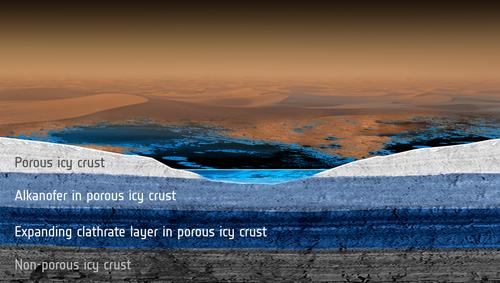
The artist's rendering above shows the hypothetical structure of the icy crust where the lakes and seas have been identified. Most lakes, seas and rivers are found in the polar areas of Saturn's largest moon. Some lakes or seas may be connected to subsurface reservoirs or clathrates and their compositon may be different from that of lakes and seas which are not connected to subsurface reservoirs or clathrates. Image Credit: ESA/ ATG medialab.
The image above corresponds to an artistic view of a presumed subsurface sea or ocean beneath the icy crust of Titan. The subsurface seas, lakes or oceans may influence the composition of some lakes or seas found in the high latitudes of the northern hemisphere depending on the level of interconnection between the pools of hydrocarbons on the surface and the presumed underground reservoirs. In this view, a submarine is exploring the exotic liquid environment below the icy crust. Image Credit: Marc Lafferre, 2014.
- To get further information on that news, go to: http://saturn.jpl.nasa.gov/news/cassinifeatures/feature20140903 or http://sci.esa.int/cassini-huygens/54582-titans-subsurface-reservoirs-modify-methane-rainfall.
August 26, 2014: A New Study Led by Chao He Shows How Titan's Haze and Tholins Can Form and Reveals the Complex Chemistry that May Have Engendered Prebiotic Molecules
Titan is well known for its enigmatic, orange atmosphere, rich in organics or hydrocarbons. The atmosphere of Saturn's largest moon is deep, thick, dense and opaque. The structure of the atmosphere is particularly complex with a haze formation and detached haze layers in the upper atmosphere. Clouds can form, in particular, in the polar areas where large cloud systems or cyclones can take shape.
Like the atmosphere of the Earth, the atmosphere of Titan is dominated by molecular nitrogen. Methane is the second most abundant molecule in the atmosphere of the giant moon. Oxygen is quasi-absent in the orange atmosphere of Titan. The ultraviolet light from the Sun plays a key role in the complex chemistry of the Titanian atmosphere since it interacts with hydrocarbons, methane, ethane or nitrogen molecules to engender new molecules, from simple molecules to complex molecules or organics.
The ultraviolet light from our star plays, in fact, a key role in the formation or the development of the orange haze. Therefore, the Titanian atmosphere appears completely opaque. The surface, the landscape or the topography can only be discerned in radar, infrared or near-infrared views acquired from the Cassini probe which has been exploring Saturn and its moons since mid-2004.
Researchers regularly advance that Titan and its atmosphere represent a prebiotic environment or a prebiotic laboratory since hydrocarbons such as methane and ethane and organics are widespread on the surface and in the atmosphere of this intriguing moon. Life on Earth may have arisen from the same kind of environment. That's why some researchers are focusing their attention on tholins and the complex chemistry of Titan's atmosphere.
A team led by Doctor Chao He, a chemist at the University of Houston who has moved to Johns Hopkins University, has recently performed an experiment aiming at reproducing the same kind of haze observed in Titan's atmosphere. The scientists tried, in fact, to generate organic substances called tholins or organic aerosols which take shape when solar light bakes the nitrogen, methane molecules or hydrocarbon molecules of Titan's atmosphere.
Very complex organic molecules have already been identified in the opaque atmosphere of Saturn's largest moon. Can complex organic molecules interact with other complex organic molecules to engender amino acids or prebiotic molecules ? Doctor Chao He advanced: "The study of organic chemistry on Titan's surface would extend our understanding of the diversity of prebiotic chemistry, and perhaps life's origin on Earth."
The analysis led by Doctor Chao He is presented in a paper appearing in the journal Icarus and entitled "Solubility and stability investigation of Titan aerosol analogs: New insight from NMR analysis". Scientists are trying to reproduce the tholins observed on Titan to better understand the way they form and the way organic molecules take shape. They must get a better understanding of the structure of tholins, of the composition of tholins and of the dynamics of tholins.
Are those organics stable and can the aerosols of tholins be dissolved in the lakes, seas or rivers of methane or ethane present in the high latitudes of Titan ? Some scientists speculate on the possibility that tholins may lead to the development of even more complex molecules and lifeforms. That's why the study upon the structure of tholins appears so crucial.
The team of Doctor Chao He carried out some experiments on the solubility of tholins and some experiments on the stability of tholins. Thus, the researchers will be in better conditions to anticipate the potential location of tholins and to develop the right detection methods. The laboratory experiment led by Doctor Chao He involved roughly the same proportions of methane and nitrogen as those present in Titan's atmosphere that is to say a 5% concentration of methane and a 95% concentration of nitrogen.
Methane and nitrogen were mixed in a reaction chamber at room temperature in order to produce tholins. In order to trigger or to boost chemical reactions, the researchers exposed the mixture to an electrical discharge for 72 hours. And the outcome was as expected since a muddy substance representing tholin took shape on the walls of the container. The tholins or organics appeared to have a similar optical appearance to what the Cassini probe had observed in the atmosphere of the Opaque Moon.
The team then performed experiments regarding the degree of solubility of the tholins in various solvents. The researchers wanted to know how well the tholins would dissolve in the solvent to which they are exposed. They tried several solvents including polar solvents and non-polar solvents. The polar solvents they incorporated were methanol, water, dimethyl sulfoxide and acetonitrile and the non-polar solvents they incorporated were pentane, benzene and cyclohexane.
Polar solvents appear fundamentally different from non-polar solvents since they generally have different electrical charges between atoms whereas non-polar solvents have identical electrical charges between atoms. For instance, water which is a polar solvent, is made of positive-charged oxygen and negative-charged hydrogen. Polar solvents tend to dissolve polar molecules best and non-polar solvents tend to dissolve non-polar molecules best.
The experiment shows that the tholins or organics preferentially dissolve in polar solvents. That implies that the lakes or seas of the polar regions, likely composed of methane and ethane, don't have a significant power to dissolve the tholins, simply because methane and ethane represent non-polar solvents. One can deduce that the tholins may be present at the bottom of the lakes or seas, surprisingly, as Doctor Chao He insists. And obviously, the tholins may be widespread on the ground. Doctor Chao He pointed out: "The tholin preferentially dissolves in polar solvents, also suggesting the tholins are composed of a large percentage of polar species."
Some researchers are working on a project to send a submarine to Titan. Kraken Mare or Ligeia Mare appear to be good candidates for this hypothetical submarine. The study of Doctor Chao He may help researchers prepare a new mission to explore the seas or lakes and the complex organics or the tholins found in the area. Scientists know that tholins can break down in hot environments. That's why the probe should not heat up the environment too much even if it is extremely cold.
If the probe manages to keep the environment at a natural temperature, it will be in a position to correctly analyze the structure of tholins with non destructive devices and methods, as Doctor Chao He explained. The scientists may resort to liquid chromatography-mass spectrometry (LC-MS) and nuclear magnetic resonance spectroscopy (NMR) in order to identify organics or tholins with detailed structural information.
By developing a new method to analyze the solubility of tholins, the team of Doctor Chao He identified several nitrogenated organic compounds in the Titanian tholins. Doctor Chao He advanced: "Some of them are very important to the prebiotic chemistry and the origin of life." The study of Doctor Chao He goes well beyond the study of Titan's organics. It can have strong implications for our understanding of other Solar System bodies such as Triton, Pluto or even Iapetus.
Doctor Chao He pointed out: "My research focuses on the astrobiology on potential environments and objects." He added: "Titan is an important one. This study helps to understand the basic properties of organics on Titan. It also provides the basis for the development of in situ analysis of methods and instruments for a Titan mission and other outer planet exploration."
The Cassini-Huygens spacecraft has allowed numerous discoveries regarding Titan and its atmosphere. In 2007, for instance, researchers found that the tholins take shape at much higher altitudes than previously thought, at altitudes higher than 1000 kilometers or 621 miles as opposed to a few hundred kilometers above the soil. The outcome also shows an unexpected high number of ions or negatively charged atoms in the Titanian clouds. And benzene molecules have been identified. They play a key role in forming the tholins.
David Young who is a researcher at the Southwest Research Institute in Texas and who led the Cassini Plasma Spectrometer (CAPS) investigation argued: "The negative ions were a complete surprise." He concluded: "This suggests they may play an unexpected role in making tholins from carbon-nitrogen precursors."
More recently, some scientists determined that the Titanian atmosphere may be older than that of Saturn. That implies that the moon may have been engendered in the disk of gas and dust surrounding the proto Sun instead of the primitive disk of ice and dust forming around Saturn. The atmosphere and the haze of Titan may well represent a treasure for our understanding of organic chemistry in the coming years or decades.
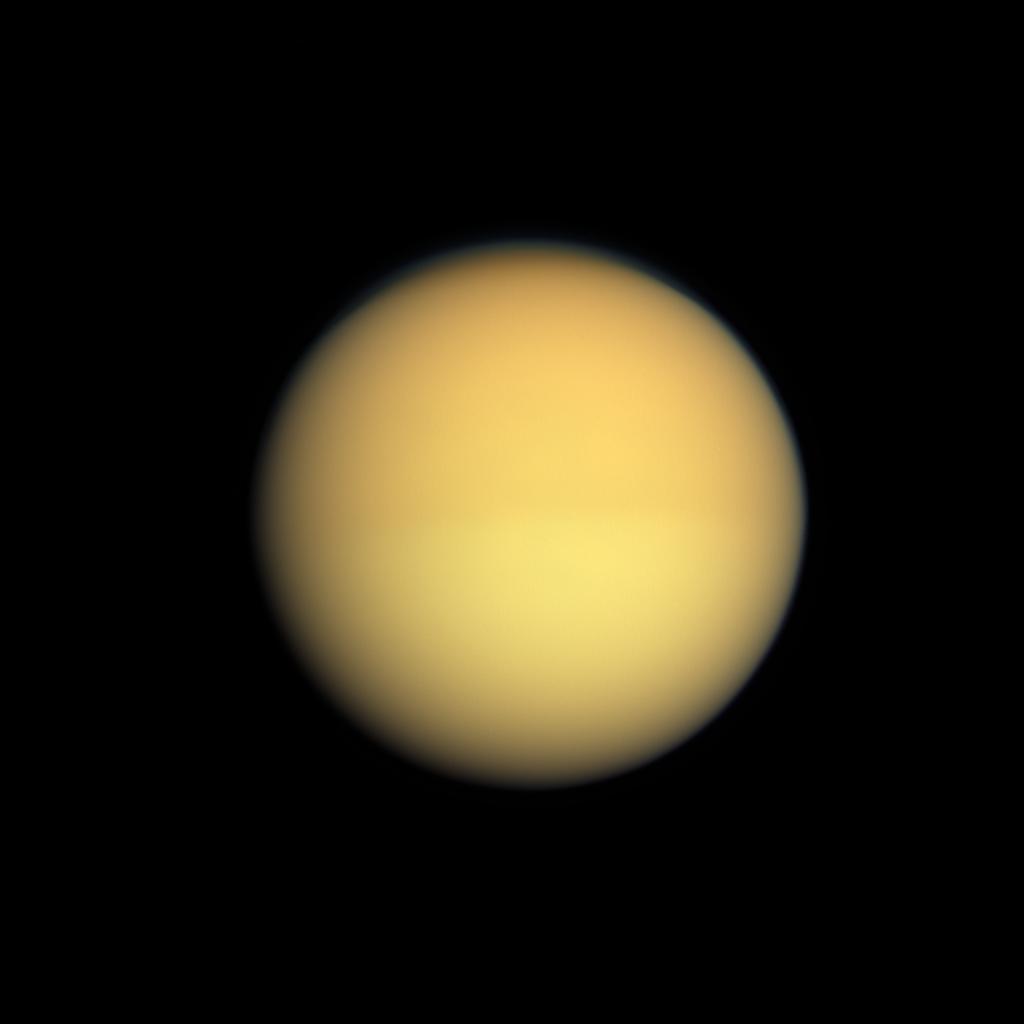
The natural color view of Titan's disc above, obtained on August 25, 2009 with the Wide-Angle Camera of the Cassini probe, reveals the opaque atmosphere of the Orange Moon and a seasonal contrast in colors between the northern hemisphere and the southern hemisphere. The Winter hemisphere seems to be richer in high-altitude haze. That's why the top half appears slightly darker. Image Credit: NASA/JPL/Space Science Institute.
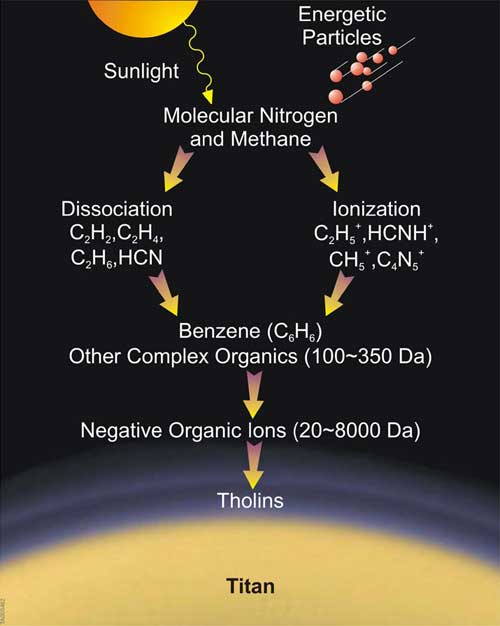
The diagram above shows the photochemical process which leads to the formation of tholins in the upper atmosphere of the Opaque Moon. The ultraviolet light from the Sun plays a key role in chemical processes occuring in the upper atmosphere. Image Credit: Southwest Research Institute.
- To get further information on that news, go to: http://www.astrobio.net/news-exclusive/titans-haze-help-us-understand-lifes-origins.
August 14, 2014: Clouds Developing and Dissipating Over Ligeia Mare Recently Imaged From the Cassini Probe
The infrared or near-infrared eye of the Cassini probe which has been exploring the Saturn system since mid-2004 allows us to see through the opaque atmosphere of Titan. Researchers are in a position to identify landscape features and even clouds since there is a meteorology involving methane on Titan.
They have realized that lakes, seas, rivers and clouds tend to be mostly concentrated in the high latitudes of the Orange Moon. The frequency, the distribution and the dynamics of clouds are key elements for understanding the interactions between the liquid bodies on the surface and the atmosphere and the way seasonal factors act on cloud development, evaporation, precipitation or condensation.
The eye of the Cassini spacecraft has recently observed a cloud system developing and dissipating over the famous methane sea Ligeia Mare found in the north polar region of Saturn's largest moon. Several images of the north polar region were taken from the Cassini probe between July 20 and July 22, 2014 as the probe moved away from the Orange Moon following a close flyby.
The timing between the different images of the area was not regular but it allowed scientists to produce an animated sequence which clearly shows the way clouds develop and dissipate over Ligeia Mare during that two-day period. Let's note that there is a 17.5-hour difference between the second and third frames whereas the difference for most other frames is only one to two hours. Researchers were able to determine, on the basis of those images, the wind speeds which are approximately 7 to 10 miles per hour or 3 to 4.5 meters per second (10.8 to 16.2 km/h).
Researchers believe, on the basis of computer models, that the development of clouds and the distribution of clouds are closely related to seasonal factors. The higher level of solar energy reaching the lakes, the seas, the rivers or the soil in the north polar region during the Summer season is expected to engender strong evaporations, the development of large cloud systems, storms and heavy precipitations.
When the Cassini spacecraft entered the Saturn system in mid-2004, the northern hemisphere of Titan was experiencing the Winter season whereas the southern hemisphere was experiencing the Summer season. The Huygens probe, which landed in the region of Shangri-La and Adiri in the equatorial or tropical region on January 14, 2005, didn't reveal any sea or lake but bright hills carved by what appeared to be dark drainage channels or fractures. That demonstrates that there may be some wet seasons in the low latitudes with heavy rainfalls.
The radar data obtained with the Radar Mapper of the Cassini probe have revealed that the dark regions found in the low latitudes of the moon, such as Shangri-La or Fensal and Aztlan, don't correspond to seas or oceans of methane or ethane since they are dominated by Seif dunes or linear and parallel dunes extending over long distances. Prevailing winds tend to shape the dunes which show some similarities with the Seif dunes found in the Namib Desert on Earth.
The first body of liquids identified on the surface of Titan was Ontario Lacus, a kidney-shaped lake or sea located in the high latitudes of the southern hemisphere. The area was experiencing the Summer period when this lake or sea was discovered with the infrared or near-infrared eye of the Cassini spacecraft. Storms or large cloud systems developing and vanishing in the area of Ontario Lacus have been frequently observed during the Summer period in the southern hemisphere.
Scientists rapidly noticed that lakes, seas, rivers and clouds were mostly found in the polar areas. The equatorial or tropical areas seemed to be particularly dry. But sporadic cirrus-like clouds had been observed at mid-latitudes. A giant vortex of ethane engulfing the north polar region had been clearly observed during the Winter period in the northern hemisphere.
The Winter season in the northern hemisphere and the Summer season in the southern hemisphere came to an end in August 2009 with the beginning of the Spring season in the northern hemisphere and of the Autumn season in the southern hemisphere. A year on Titan corresponds to approximately 30 Terrestrial years and each season lasts about 7 Terrestrial years. That's why scientists still have an incomplete view of Titan's meteorology.
As the Summer season in the northern hemisphere approaches, the level of light and the energy reaching the damp area of Titan's north polar region are going up and the infrared or near-infrared eye of the Cassini probe can obtain better views of the land of lakes and seas.
Surprisingly, a rupture can be noted regarding the frequency of cloud observations since the development of a huge storm or a cloud outburst across the low latitudes of the Opaque Moon in late 2010. Clouds had been frequently observed in the south polar region or at low latitudes up to the development of this cloud system in 2010 but after that cloud development, only a few small clouds have been identified on Titan.
That's not exactly in line with what the computer simulations of Titan's atmospheric circulation anticipate because the northern hemisphere and the north polar region, in particular, should become cloudier as the Spring season advances and as the Summer period approaches and develops.
If the solar energy reaching the north polar lakes or seas increases, the evaporation process is expected to increase engendering the formation of clouds via typical condensation phenomena. That's a familiar cycle that we encounter everyday on Earth. But, on Titan, the cycle is based on methane instead of water.
Elizabeth Turtle, a Cassini imaging team associate at the Johns Hopkins University Applied Physics Lab in Laurel, Maryland pointed out: "We're eager to find out if the clouds' appearance signals the beginning of summer weather patterns, or if it is an isolated occurrence." She added: "Also, how are the clouds related to the seas? Did Cassini just happen catch them over the seas, or do they form there preferentially?"
Do the clouds observed over Ligeia Mare signal a real start for depressionary phenomena in the area during the relatively warm season ? Researchers need to continue to monitor the area and to gather information regarding the shape and the appearance of the lakes or seas and meteorological phenomena to get a better understanding of the Titanian meteorology.
The persistence of methane in Titan's atmosphere is intriguing scientists because it should have disappeared over time under the action of ultraviolet light from the Sun. There may be some internal sources but no clear sign of cryovolcanism or geyser has been clearly identified yet. Are the clouds observed over Ligeia Mare related to cryovolcanism ? Why not !
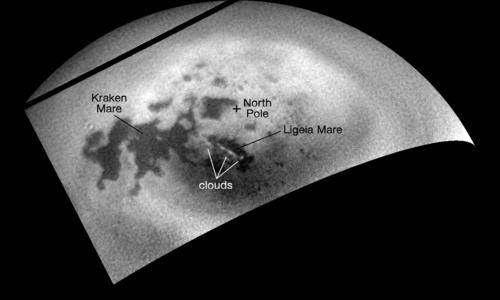
The view above corresponds to an orthogonal view of the area of Ligeia Mare. This annotated image is the outcome of a reprojection of a view taken with the Narrow-Angle Camera of the Cassini probe on July 21, 2014. Several clouds can be seen over the methane lake or sea Ligeia Mare. Image Credit: NASA/JPL-Caltech/Space Science Institute.
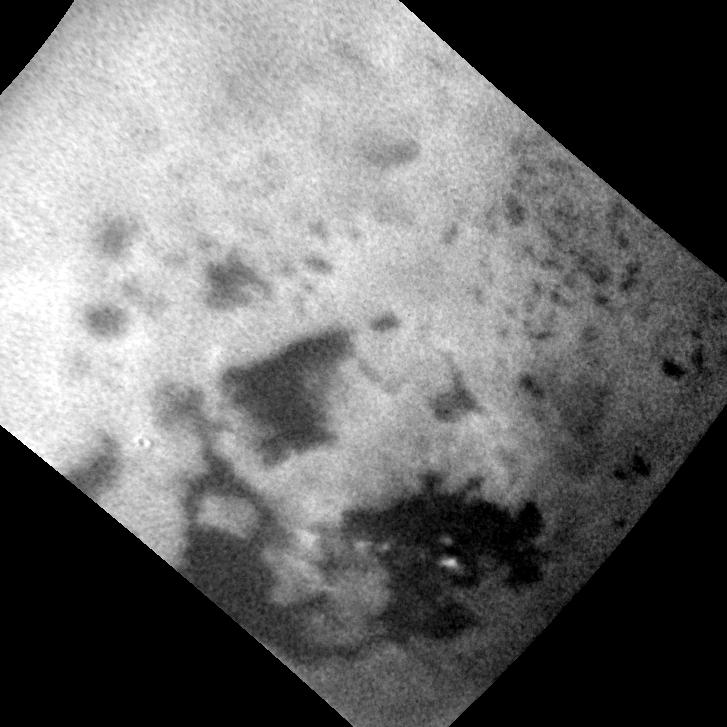
The image above showing the dark lake or sea Ligeia Mare and a portion of Kraken Mare corresponds to a frame of an animated sequence generated on the basis of several images obtained from the Cassini spacecraft between July 20 and July 22, 2014 as it receded from Titan following a close flyby. One can notice several bright clouds developing over Ligeia Mare. Image Credit: NASA/JPL-Caltech/Space Science Institute.
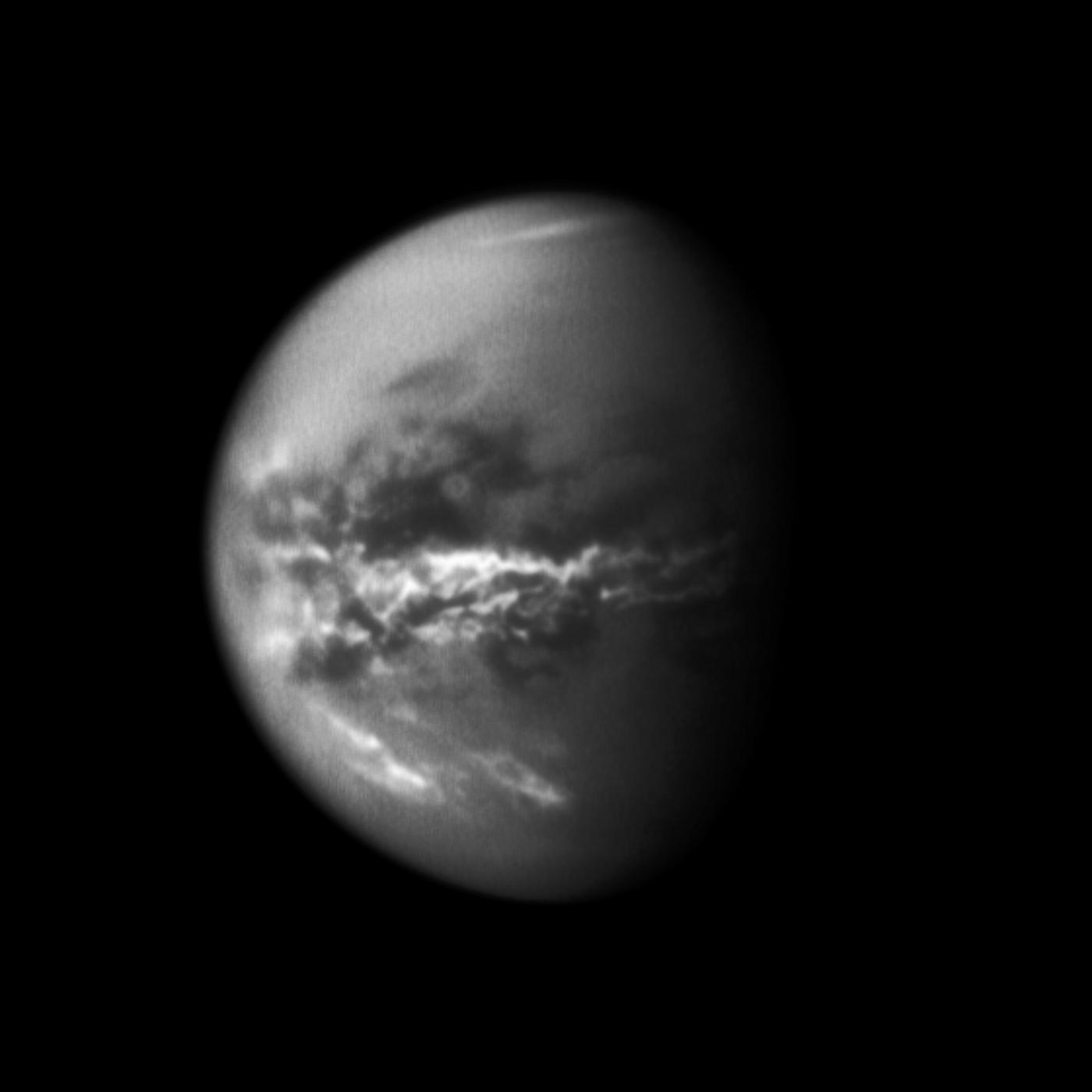
The view above generated on the basis of images obtained on October 18, 2010 with the Narrow-Angle Camera of the Cassini probe reveals an unfamiliar view of Titan's disc since large cloud systems concentrated in low latitudes can be clearly noticed. The image is made of an average of three views acquired using a filter sensitive to wavelengths of near-infrared light centered at 938 nanometers as well as an image obtained using a filter sensitive to visible light centered at 619 nanometers. Thus, one can identify surface features as well as clouds forming in the Troposphere. Image Credit: NASA/JPL/SSI.
- To get further information on that news, go to: http://saturn.jpl.nasa.gov/news/newsreleases/newsrelease20140812.
July 28, 2014: An Atmospheric Model Proposed by Vladimir Krasnopolsky Remarkably Predicts the Observed Chemical Processes in Titan's Atmosphere
Vladimir Krasnopolsky, a professor from the Moscow Institute of Physics and Technology who heads the Laboratory of High Resolution Infrared Spectroscopy of Planetary Atmospheres and who is regarded as a leading global expert upon the atmosphere of moons and planets of the Solar System, has developed an atmospheric model of Titan which accurately reproduces the chemical structure and the chemical processes of Titan's atmosphere and ionosphere.
He published the results of his study in the journal Icarus of July 2014. The paper which appears in the volume 236 of the journal Icarus is entitled "Chemical composition of Titan's atmosphere and ionosphere: Observations and the photochemical model".
The results of the photochemical model of Titan's atmosphere and ionosphere are remarkably close to the reality observed in the deep, opaque, thick and dense atmosphere of Saturn's largest moon. The mathematical model allows us to analyze and compare the chemical composition of Titan's orange atmosphere with our own atmosphere on the basis of different parameters from the model.
The photochemical model of Vladimir Krasnopolsky tried to reproduce the Titanian atmosphere by taking into account the presence of 83 neutral molecules and 33 ions from the surface to 1600 km. The model also shows 420 different chemical reactions between the molecules or ions.
Titan and the Saturn System are found much further from the Sun than the Earth, at a distance of about 1.4 billion km from the Sun compared to only about 150 million km for the Earth. Therefore, the radiation flux emanating from the Sun is particularly weak at the level of Titan. The solar energy received by Titan is approximately 100 times weaker than the solar energy received by the Earth.
That's why the environmental temperature at the level of the surface on Titan is around -180 degrees Celsius, 93 Kelvin or -292 degrees Fahrenheit. However, the solar energy plays a key role in the chemical processes of Titan's atmosphere. The intensity of ultraviolet light is strong enough to engender photochemical reactions in the upper layers of the Titanian atmosphere.
The photochemical model predicted, on the basis of calculations, the formation of haze by polymerization of hydrocarbons and nitriles as well as recombination processes of heavy ions and condensation of various molecules near the tropopause. The model shows a global deposition of a layer of 300 meters thick for the age of the Solar System. Nitrogen is supposed to represent 8% of the deposition. The mathematical model remarkably predicts basic observations upon hydrocarbons, nitriles and ions on the Opaque Moon.
The atmosphere of Titan appears to be mainly composed of molecular nitrogen like the atmosphere of the Earth. Methane turns out to be the second most abundant gas in the deep atmosphere of Titan. The Huygens spacecraft which landed onto the Adiri/Shangri-La region on January 14, 2005 recorded an atmospheric pressure on the surface of 1467 hPa which is significantly higher than the typical atmospheric pressure at sea level on our planet which is around 1013 hPa. As a result, the air is significantly denser near the surface on Titan than near the surface on Earth.
Key data upon the composition, the structure and the chemical processes of Titan's atmosphere were obtained from the instruments of the Huygens probe and the Cassini spacecraft. The Cassini orbiter which entered the Saturn System in mid-2004 is equipped with ultraviolet and infrared spectrometers for studying the surface, the atmosphere or the ionosphere.
The Cassini Plasma Spectrometer (CAPS) or the Ion and Neutral Mass Spectrometer (INMS) designed specifically for this study have collected enough data to perform a comparative analysis on the basis of mathematical models. The Huygens probe collected, during its atmospheric descent, key data on the distribution of aerosol particles in the Titanian atmosphere.
Cassini and Huygens have probably gathered the most significant data upon the chemistry or the dynamics of Titan's atmosphere but the data of other instruments may not be forgotten due to their significant role. For instance, part of the data was acquired using the IRAM ground submillimeter telescope and the Herschel infrared space observatory.
Vladimir Krasnopolsky insists on the fact that the theoretical description of the Titanian atmosphere enabled by his photochemical model is remarkably accurate on the basis of observations gathered from the Cassini spacecraft and the Huygens probe in particular. He admits that there are discrepancies but he argues that they are caused by inevitable measurement errors. There are uncertainties regarding the nature of some molecules or the concentrations of many molecules. In other words, the concentrations of many molecules are approximate.
Vladimir Krasnopolsky pointed out: "The coherence of the model with reality means that we can correctly tell where different substances go from Titan's ionosphere and where they come from." Overall, the photochemical model of the Titanian atmosphere and ionosphere is correct because the main chemical processes of the haze or the orange atmosphere are correctly reproduced or simulated. In fact, differences between the model and the observational data are comparable to differences between the observations of different researchers.
The complex and dynamic atmosphere of Saturn's largest moon continues to fascinate scientists due to its resemblance to the atmosphere of the Earth. There is a methane cycle on Titan similar to the water cycle on Earth. Lakes, seas, rivers, evaporation, condensation, clouds or precipitation processes take shape on the Orange Moon Titan.
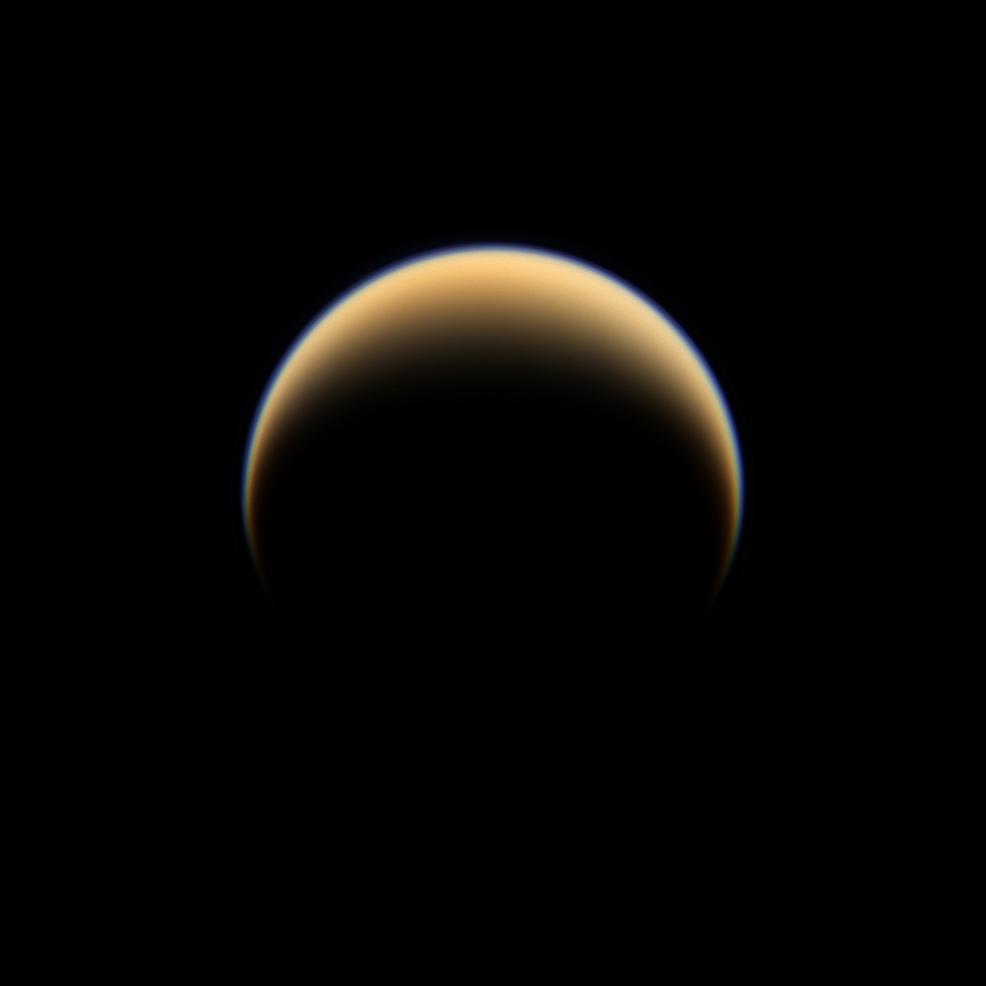
The view above corresponds to a natural color image of Titan and reveals an orange northern crescent. The dark portion of the northern hemisphere corresponds to the night area whereas the colorful area corresponds to the day area. The view was generated on the basis of images acquired using red, green and blue spectral filters. The three views were taken with the Wide-Angle Camera of the Cassini probe on June 6, 2009 at a distance of about 194,000 kilometers or 121,000 miles from the Opaque Moon. The north pole appears to be tilted approximately 23 degrees to the left. The blue layer of the upper atmosphere can be well discerned here. Image Credit: NASA/JPL/Space Science Institute.
- To get further information on that news, go to: http://mipt.ru/en/news/titan_s_atmosphere_20140721.
July 3, 2014: The Presumed Subsurface Ocean of Titan May Be As Salty As the Dead Sea
Scientists believe that several moons in the Solar System may be composed of a subsurface ocean or of subsurface seas. Enceladus, Titan, Europa, Ganymede, Callisto or Triton appear to be strong candidates regarding the possibility of an underground ocean.
Since the arrival of the Cassini-Huygens spacecraft into the Saturn System in mid-2004, the Cassini orbiter and the Huygens lander have collected and transmitted a huge amount of data regarding the atmosphere, the surface, the topography and even the interior of Saturn’s largest moon.
Topography and gravity data obtained from the Cassini probe during its multiple flybys of the Orange Moon have allowed a group of researchers to develop a new model regarding the structure of the moon and to strengthen the hypothesis for an internal ocean roughly as salty as the Dead Sea on Earth. This presumed underground ocean may be found beneath an outer icy shell.
The team of researchers led by Giuseppe Mitri of the University of Nantes in France recently published the findings in the journal Icarus. Linda Spilker, Cassini project scientist at NASA’s Jet Propulsion Laboratory in Pasadena, California who was not part of the team who performed the study advanced: “Titan continues to prove itself as an endlessly fascinating world, and with our long-lived Cassini spacecraft, we’re unlocking new mysteries as fast as we solve old ones.”
The outer ice shell of the Opaque Moon is now better understood by scientists. The researchers confirm the well-established hypothesis according to which the icy shell is rigid and in the process of freezing solid on the basis of Cassini data.
The gravity data of Titan are consistent with the hypothesis of a relative high-density ocean beneath the icy crust. If this subsurface ocean is relatively dense, what can it be composed of? The researchers think that this hidden ocean may be an extremely salty brine of water mixed with dissolved salts probably made up of sulfur, sodium and potassium.
If this hypothetical mixture is correct, the level of density found implies that the presumed subsurface ocean may be as salty as the saltiest seas on Earth. In other words, the hypothetical subsurface ocean of the Opaque Moon may be, roughly, as salty as the Dead Sea on our planet.
Giuseppe Mitri who is, let’s recall it, the lead author of the paper entitled “Shape, topography, gravity anomalies and tidal deformation of Titan” pointed out: “This is an extremely salty ocean by Earth standards.” He argued: “Knowing this may change the way we view this ocean as a possible abode for present-day life, but conditions might have been very different there in the past.”
One knows that some bacteria can thrive in the harsh conditions of a highly-salty sea but obviously, a body of liquids similar to the Dead Sea doesn’t seem to allow the presence of a wealthy ecosystem or biosphere.
The data acquired from the Cassini probe also suggest that the thickness of the ice crust is not perfectly uniform. In fact, the ice crust turns out to vary slightly geographically. The team advances that this configuration is consistent with a stiff outer shell.
The presumed stiff outer layer may be the outcome of a slow crystallization process of the hypothetical ocean. This ocean may be progressively turning to ice and that’s why the outer shell may not be uniform in terms of thickness. A more stable interior over time will tend to engender a more uniform shape of the moon and of its outer shell. Some scientists compare this phenomenon to warm candle wax.
This freezing or crystallization process of the hypothetical ocean would have significant implications for the habitability or the life potential of a subsurface ocean on the Orange Moon since it would lower the ability of compounds to migrate between the surface and the subterranean ocean, with the absence or quasi-absence of convection or plate tectonics.
In their study, Giuseppe Mitri and his collaborators postulate that methane gas, which is the second most abundant gas in Titan’s atmosphere and which can represent up to 5% of its composition, is not released uniformly from the ground into the Titanian atmosphere and is released at scattered “hot spots” engendering outgassing of methane.
This scenario is closely related to their hypothesis of a rigid ice crust or ice shell which is supposed to prevent convection or plate tectonics to occur. That implies that the ice shell is not really recycled and that methane intermittently fuels the atmosphere from hot spots like geysers or volcanoes which can produce transient eruptions.
A parallel between the hypothetical hot spots of Titan and hot spots on Earth can be drawn. The island of “La Réunion” found in the Indian Ocean corresponds to a hot spot with the active volcano known as the “Piton de la Fournaise” which regularly wakes up and erupts to generate lava flows which tend to enlarge the island. A parallel can also be drawn with the hot spot that gave birth to the Hawaiian Island chain.
The hypothesis according to which the methane gas from the Titanian atmosphere is released from an underground ocean of methane and passing through a porous ground is not considered here. Scientists have always been intrigued by the persistence of a high proportion of methane in Titan’s atmosphere because methane molecules tend to be broken apart by ultraviolet light on relatively short geological timescales. New molecules form in Titan’s upper atmosphere under the action of sunlight and ultraviolet light in particular.
Methane should have disappeared unless there is an internal source which regularly or constantly replenishes the atmospheric methane. Localized and intermittent releases of methane are consistent with the rigid ice shell configuration as the study of Giuseppe Mitri and his collaborators advances.
Jonathan Lunine, a researcher on the Cassini mission at Cornell University, Ithaca, New York, who represents one of the authors of the paper argued: “Our work suggests looking for signs of methane outgassing will be difficult with Cassini, and may require a future mission that can find localized methane sources.” He concluded: “As on Mars, this is a challenging task.” Cryovolcanoes spewing methane or salty water may tell us a lot regarding the chemistry below the icy crust in the hypothetical subsurface ocean.
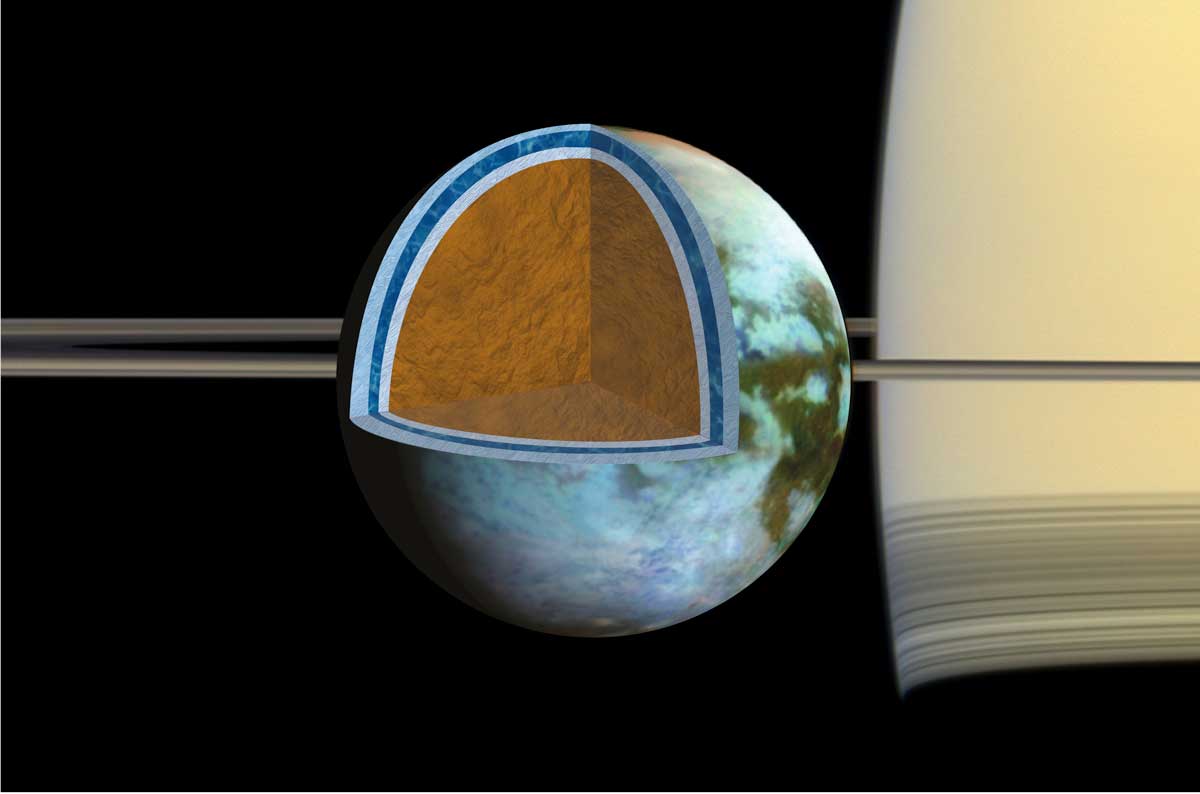
The artist's impression above, showing a portion of Saturn and its largest moon Titan, unveils the hypothetical internal structure of the Opaque Moon. A subsurface ocean, particularly salty, may be found below an irregular external icy crust. Image Source: NASA/JPL-Caltech.
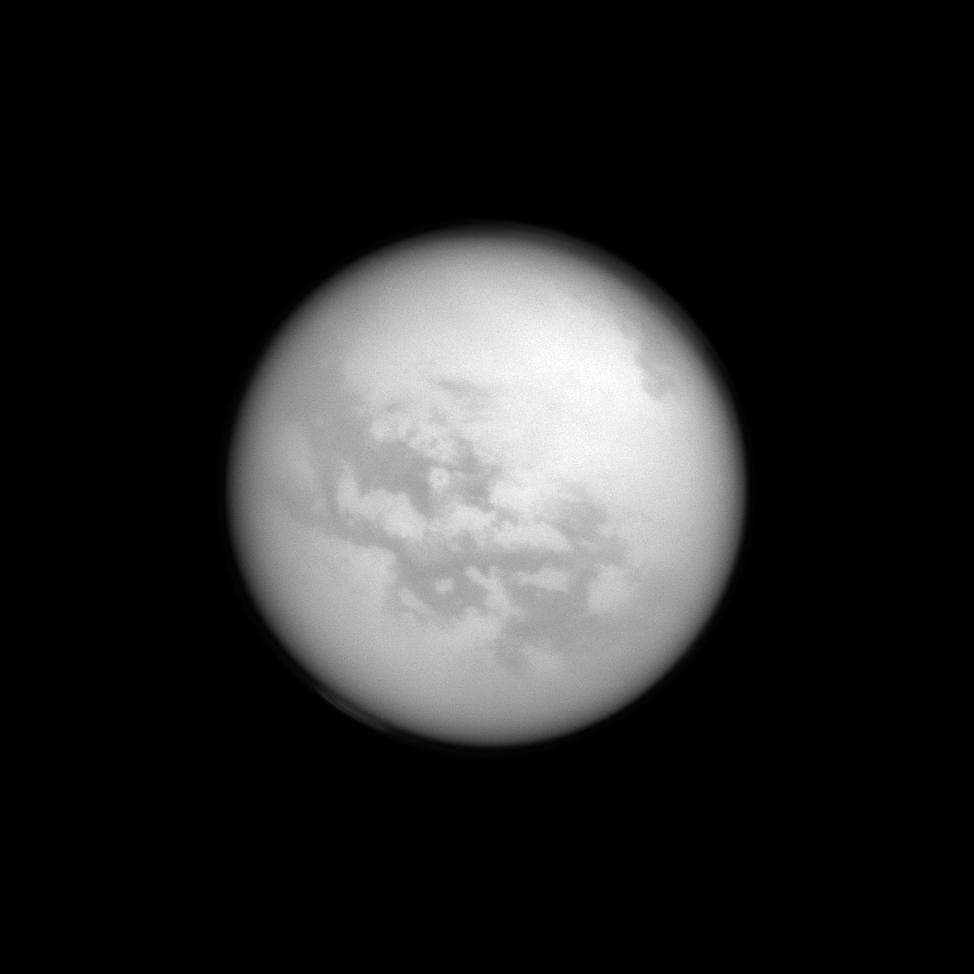
The image above corresponds to a near-infrared view of Titan obtained with the Narrow-Angle Camera of the Cassini probe on April 13, 2013. The surface of the moon can be clearly observed with a spectral filter sensitive to wavelengths of near-infrared radiations centered at 938 nanometers. One can clearly notice the contrast between bright and dark regions. The dark regions are mostly found in the low latitudes of the Orange Moon. The dark regions Fensal and Aztlan as well as the bodies of liquids in the high latitudes of the northern hemisphere or in the north polar region can be clearly observed here. The north is found in the upper right part of the disk and is inclined 32 degrees to the right. A subsurface ocean may be hidden below the external shell. Image Credit: NASA/JPL-Caltech/Space Science Institute.
The artist's impression above shows a submarine exploring the hypothetical subsurface ocean of Saturn's largest moon Titan. The presumed subsurface ocean may be found beneath an external icy crust. The subsurface ocean may be composed of liquid water and may be particularly salty. The artistic view above unveils the lower limit of the icy crust. Is there an extraterrestrial lifeform based on liquid water in this exotic, hypothetical environment? Bioluminescent lifeforms may be present there. Two completely different lifeforms may coexist on Titan and inside Titan, a lifeform based on liquid methane or liquid ethane in the lakes or seas of hydrocarbons and a lifeform based on liquid water in the presumed liquid environments dominated by liquid water beneath the icy crust. Image Credit: Marc Lafferre, 2014.
- To get further information on that news, go to: http://saturn.jpl.nasa.gov/news/newsreleases/newsrelease20140702.
June 27, 2014: Radar Data Reveal the Appearance of a “Magic Island” in Ligeia Mare Probably Related to a Decrease in the Lake Level
Since the arrival of the Cassini-Huygens probe in the Saturn system in mid-2004, the Radar Mapper of the Cassini probe has turned out to be a very powerful tool to collect topographic or landscape data of the Opaque Moon Titan.
Scientists have been in a position to combine infrared, near-infrared and radar data in order to better analyze landscape or topographic features on Titan. Infrared or near-infrared images apparently reveal bright regions like Xanadu or Adiri and dark regions like Shangri-La, Fensal and Aztlan.
The dark areas which are mostly found in the low latitudes of the moon appear to be dominated by Seif dunes or linear and parallel dunes extending over long distances. Those dunes can be clearly noticed in radar images which reveal the famous “Cat Scratches”.
The radar data obtained from the Radar Mapper have clearly shown that lakes, seas and rivers are mostly found in the high latitudes or in the polar regions of the Orange Moon. The south polar region of Saturn’s largest moon is dominated by Ontario Lacus, the first lake or sea clearly identified on Titan and the north polar region is made up of a myriad of lakes, seas and rivers.
Kraken Mare, Ligeia Mare and Punga Mare appear to be the three largest bodies of liquids in the high latitudes of the northern hemisphere. The north polar region appears to be significantly damper than the south polar region. Scientists are intrigued by this dichotomy but it may be related to seasonal factors.
The Summer season in the southern hemisphere and the Winter season in the northern hemisphere came to an end in August 2009 with the Vernal Equinox. The northern hemisphere is now encountering the Spring season. In parallel, the southern hemisphere is experiencing the Autumn season. Some researchers hypothesize that the north polar region is going to be less and less damp as the Summer solstice of May 2017 approaches.
A new study published in the journal Nature Geoscience on June 22 and proposed by Jason Hofgartner, a Cornell graduate student in the branch of planetary sciences, Alex Hayes, assistant professor of planetary sciences, Jonathan Lunine, the David C. Duncan Professor in the Physical Sciences and Phil Nicholson, professor of astronomy shows, on the basis of radar images, the appearance of a bright feature in the uniformly dark Ligeia Mare.
The researchers resorted to the well-known technique of flipping to identify this new geologic feature clearly observed in the radar data sent on July 10, 2013 to the Jet Propulsion Laboratory at the California Institute of Technology from the Cassini probe. The bright feature in the middle of the big lake or the small sea Ligeia Mare, mostly composed of methane and ethane, has been dubbed the “Magic Island”, simply because it wasn’t there in the previous radar data of the area.
The enigmatic Magic Island appears close to the well-defined coastline made of several peninsulas. Its appearance in terms of brightness and shape is close to that of the other features of the coastline. That’s why one may reasonably think that the “Magic Island” is really an island, a new island and perhaps a transient island.
The researchers argue that this phenomenon may correspond to the first observation of dynamic, geological processes occurring in the northern hemisphere of Saturn’s largest moon. Jason Hofgartner who is the lead author of the study pointed out: “This discovery tells us that the liquids in Titan’s northern hemisphere are not simply stagnant and unchanging, but rather that changes do occur.” He added: “We don’t know precisely what caused this ‘magic island’ to appear, but we’d like to study it further.”
The flipping method used to unveil the intriguing “Magic Island” is a technique which has been very fruitful in terms of asteroid, comet, moon or planet discovery. Scientists need to be particularly concentrated in order to detect or identify changes between old and new images of the same area. And the flipping technique is very relevant in the analysis of lake dynamics which can be closely related to meteorological phenomena such as precipitation, evaporation or winds. Jason Hofgartner advanced: “With flipping, the human eye is pretty good at detecting change.”
Before the observation of radar data sent in July 2013, one can point out that the area of Ligeia Mare hadn’t shown any dynamic feature such as waves. The various analyses have shown that the lakes or seas on Titan tend to be remarkably quiet or flat. Some lakes or seas may even be almost as flat or smooth as a mirror.
But as the Summer season approaches in the northern hemisphere, the lakes or seas may become more and more dynamic with higher waves because the increasing solar energy reaching the area should bring storms or turbulences.
Jason Hofgartner and his collaborators believe that the appearance of the famous “Magic Island” may be caused by changing seasons. They advance four possibilities. The “Magic Island” or “Ghost Island” may be in fact the outcome of strong waves engendered by the development of northern hemisphere winds. In other words, the stronger-than-usual winds produce local waves which look like an island in radar images.
Another hypothesis is that gases may erupt from the sea floor of Ligeia Mare. Their rise to the surface of the sea or lake would generate bubbles. This field of bubbles would resemble an island in radar images. So far, no clear topographic sign of cryovolcanism or geyser has been identified on Titan.
A third hypothesis put forward by the team corresponds to the development of an iceberg. As the Spring season develops, environmental temperatures in the area tend to go up and some sunken solids produced by a wintry freeze would have become less dense, lighter. In that configuration, they become buoyant and they appear as an island in radar views.
The fourth hypothesis advanced by Jason Hofgartner and his collaborators is the fact that the small sea or giant lake Ligeia Mare has suspended solids, which are neither sunken nor floating, but act like silt in a delta on our planet.
Jason Hofgartner explained: “Likely, several different processes - such as wind, rain and tides - might affect the methane and ethane lakes on Titan. We want to see the similarities and differences from geological processes that occur here on Earth.” He concluded: “Ultimately, it will help us to understand our own liquid environments here on the Earth.”
Researchers are always astonished to notice the various similarities between the landscape on Titan and the landscape on Earth. Like on Earth, Titan is made of lakes, seas, rivers, mountains, hills, dune fields, plateaus or eroded terrain. There are clouds, evaporation processes, precipitation processes or cyclones and, like on Earth, the atmosphere of Titan is mostly composed of molecular nitrogen. But the resemblance has its limits. Oxygen is almost absent of the Titanian atmosphere and methane is present in this exotic atmosphere in a relatively high proportion.
The “Magic Island” may well be the outcome of a decrease in the level of the lake or sea which unveils landscape features which were previously hidden at a relatively low depth below the surface of the sea or lake. Strong evaporation processes may be currently occurring due to changing seasons and the approach of the Summer solstice. But the seasons are relatively long and it may take time to verify.
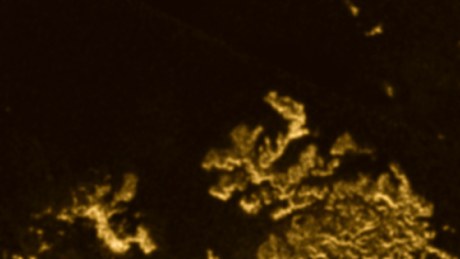
The colorized radar view above, based on data acquired from the Cassini probe, reveals the usual coastline of Ligeia Mare, a major lake or sea in the high latitudes of Titan's northern hemisphere. Image Credit: NASA/JPL-Caltech/Cornell.
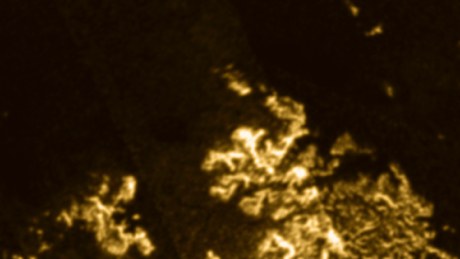
The image above, resulting from data sent on July 10, 2013 to the Jet Propulsion Laboratory from the Cassini probe, corresponds to another radar view of Ligeia Mare which shows an unusual topographic feature. This landscape feature seems to be a new island. Is it linked to a decrease in the lake or sea level? Image Credit: NASA/JPL-Caltech/Cornell.
| The artistic views in the upper part of the
table, based on the Shape From Shading technique, represent the area of
Ligeia Mare where the Magic Island has been clearly identified in radar
data obtained from the Radar Mapper of the Cassini probe. In the
simulated view of the upper left part of the table, based on the radar
image of the lower left part of the table, the Magic Island is not
there. In the simulated view of the upper right part of the table, based
on the radar image of the lower right part of the table, the Magic
Island can be clearly noticed. The Magic Island appears in the lower
left part of the image. The debate upon the origin of the Magic Island
is open. Is it related to a decrease in the lake level, to a
cryovolcano, to an iceberg, to a monster...? The grey arrow in the radar
images shows the orientation of the virtual camera.
Credit for the artistic views:
Marc Lafferre, 2014. |
|
| The artistic images in the upper part of
the table, based on the Shape From Shading technique, unveil the area of
Ligeia Mare where the Magic Island has been clearly spotted in radar
data taken from the Radar Mapper of the Cassini spacecraft.
In the simulated image of the upper left part of the table, based on the
radar image of the lower left part of the table, the Magic Island is not
there. In the simulated image of the upper right part of the table,
based on the radar image of the lower right part of the table, the Magic
Island can be clearly identified. The Magic Island can be found in the
right part of the image. The grey arrow in the radar images shows the
orientation of the virtual camera which is different here from the
configuration in the artistic views in the previous table.
Credit for the artistic views:
Marc Lafferre, 2014. |
|
- To get further information on that news, go to: http://news.cornell.edu/stories/2014/06/mysterious-magic-island-appears-saturn-moon.
June 26, 2014: A New Study Suggests that Nitrogen in Titan’s Atmosphere May Derive From the Cold Disk of the Primitive Solar System Rather Than From the Primitive Saturnian Disk
The atmosphere of Titan and the atmosphere of the Earth are mostly composed of molecular nitrogen. Do the nitrogen molecules of Titan’s atmosphere have the same origin as the nitrogen molecules of the Terrestrial atmosphere?
A new study led by Kathleen Mandt of Southwest Research Institute in San Antonio, published recently in the Astrophysical Journal Letters, involving collaborators from CNRS or France’s National Center for Scientific Research and from Observatoire de Paris and funded by NASA and the European Space Agency (ESA), reveals strong evidence that the atmospheric nitrogen of Titan may find its origin in the primitive disk or cloud of cold gas and dust that led to the formation of the Solar System.
This conclusion implies that the atmospheric nitrogen of Titan wouldn’t find its origin in the primitive disk surrounding Saturn. The molecular nitrogen of Titan’s atmosphere may result, in fact, from the disk which formed, via condensation phenomena and accretion phenomena, our Sun. The building blocks of the Orange Moon may have formed earlier than expected at the beginning of the Solar System’s history, roughly 4.6 billion years ago.
The team of Kathleen Mandt focused its attention on the ratio of one isotope of nitrogen, called nitrogen-14 to another isotope, called nitrogen-15. The team advanced that this ratio should be fundamentally the same today as when the Opaque Moon took shape at the beginning of the history of the Solar System.
The researchers assume that the atmospheric nitrogen of Titan finds its origin in conditions which resemble the cold birthplace of the most ancient comets from the Oort cloud located about 1 Light Year away from us. One may find a roughly similar ratio of nitrogen isotope in the atmosphere of Titan and in the comets which have taken shape in the Oort cloud and whose composition has been very stable over time. The nitrogen ratio of Titan’s atmosphere may be similar to the primitive nitrogen ratio of comets from the Oort cloud and different from the nitrogen ratio of comets from the Kuiper Belt.
Kathleen Mandt and her team pointed out that, contrary to what had been commonly hypothesized by researchers, the Solar System is too young for this nitrogen isotope ratio to have evolved significantly. Kathleen Mandt advanced: “When we looked closely at how this ratio could evolve with time, we found that it was impossible for it to change significantly. Titan’s atmosphere contains so much nitrogen that no process can significantly modify this tracer even given more than four billion years of solar system history.”
The Rosetta mission developed by ESA is about to bring crucial data regarding the hypothesis upon the origin of the atmospheric nitrogen of Titan. The spacecraft of the Rosetta mission is going to study a Kuiper Belt comet known as 67P/Churyumov-Gerasimenko. The Kuiper Belt comets evolve far closer to the Sun than the Oort cloud comets since the Kuiper Belt starts, in its inner part, near the orbit of the Gas Giant Neptune.
The team anticipates or predicts that the comet 67P/Churyumov-Gerasimenko has a smaller ratio of two isotopes (in this situation of hydrogen in methane ice) than the ratio on the Opaque Moon because the ratio of nitrogen isotope nitrogen-14 to nitrogen-15 in the atmosphere of Titan is expected to be closer to that of Oort cloud comets than to comets originating in the Kuiper Belt.
The analysis of isotopes can be particularly fruitful in the field of planetary exploration because the proportions or the ratio of the isotopes of a specific element tend to be closely related to the conditions of the primitive environment or to the conditions under which the materials take shape.
This study regarding the isotope ratio of nitrogen allows scientists to better understand the formation and the evolution of the Solar System. And it raises some questions regarding the atmosphere of our planet. Where does the nitrogen of our atmosphere come from? Is it the outcome of comet rains?
A well established idea or hypothesis suggests that our oceans and our atmosphere may have formed under the action of comet impacts since comets tend to be composed of water ice and ammonia ice. The new study puts this hypothesis into question and supports the approach according to which ammonia ice from comets may not be the primary source of the Terrestrial nitrogen.
Previous theories had developed the idea that nitrogen isotope ratio in the original atmosphere of Saturn’s largest moon was similar to that of the Earth’s atmosphere today and that there was a close link between comets, Titan and Earth. It appears, on the basis of measurements taken by instruments of the Cassini-Huygens spacecraft, that the nitrogen isotope ratio in Titan’s atmosphere is different from that of Earth’s atmosphere.
That clearly implies that the sources of nitrogen in the atmosphere of the Blue Planet and in the atmosphere of the Orange Moon may have corresponded to different processes. Some scientists had previously believed that the nitrogen isotope ratio of the Earth has not evolved significantly since the early stages of the planetary formation of the Earth.
The weak changes in the isotope ratio of nitrogen, over long periods of time, allow scientists to perform comparisons or analyses regarding the original building blocks of Titan and other moons or planets. Are there relationships in the origin of Titan’s atmosphere and in the origin of Neptune’s atmosphere, for instance?
Kathleen Mandt pointed out: “Some have suggested that meteorites brought nitrogen to Earth, or that nitrogen was captured directly from the disk of gas that formed the sun. This is an interesting puzzle for future investigations.”
Scott Edgington, Cassini deputy project scientist at NASA’s Jet Propulsion Laboratory, Pasadena, California advanced: “This exciting result is a key example of Cassini science informing our knowledge of the history of solar system and how the Earth formed.”
Recently, we may have witnessed, for the first time, the formation of a new moon around Saturn, in one of its rings but Titan may have a different origin and the nitrogen of its atmosphere may paradoxically result from the primitive disk of gas and dust that led to the formation of the Sun. That’s what the isotopic analysis suggests.
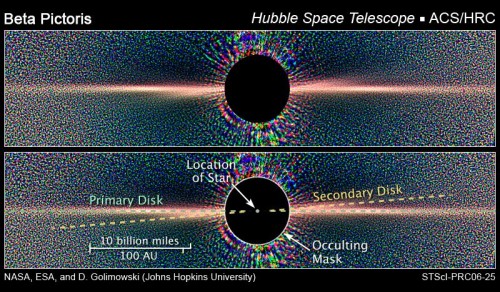
The image above, obtained from the the Hubble Space Telescope, shows the famous Beta Pictoris System which corresponds to a young star system or to a forming star system. Two disks of debris or two disks of gas and dust can be well discerned here as the lower view of the mosaic indicates. Beta Pictoris can be found inside the dark circular mask. The researchers believe that Titan and its atmosphere of nitrogen and methane may have been formed inside a similar disk during the formation process of our Sun. The hypothesis according to which Titan and its atmosphere may have taken shape in the disk around Saturn is losing some ground. Image Credit: NASA/ESA and D. Golimowski (Johns Hopkins University).
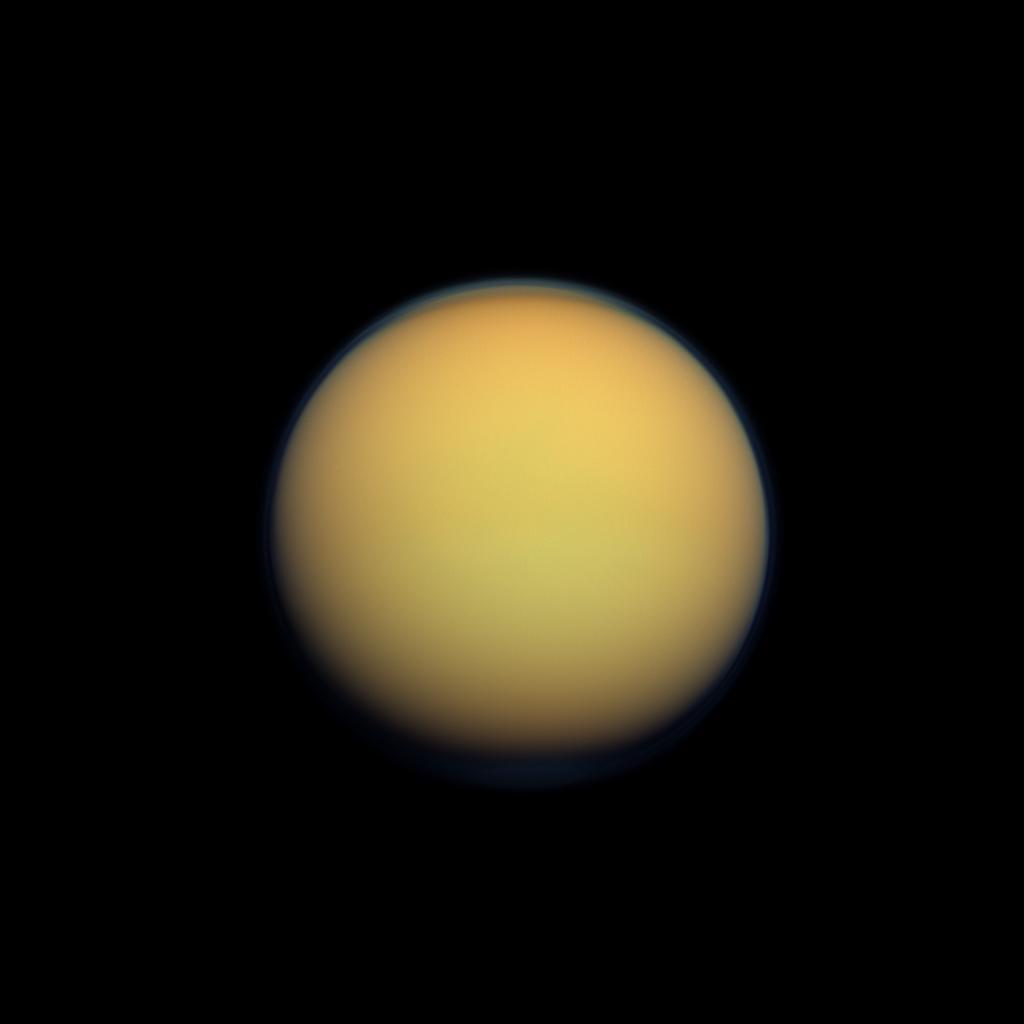
The image above corresponds to a natural color view of Saturn's largest moon Titan produced on the basis of images taken using red, green and blue spectral filters with the Wide-Angle Camera of the Cassini probe on January 30, 2012 at a distance of about 119,000 miles or 191,000 kilometers from the Opaque Moon. One can notice in particular the north polar hood in the upper part of the disk as well as the blue detached-haze layer found in the upper part of Titan's complex atmosphere. Is the formation process of Titan and its atmosphere related to a planetary disk around Saturn or to the primitive disk of gas and dust around the proto-Sun? Image Credit: NASA/JPL-Caltech/Space Science Institute.
- To get further information on that news, go to: http://saturn.jpl.nasa.gov/news/newsreleases/newsrelease20140623.
June 18 2014: NASA Researchers Perform Experiments that Reproduce Aromatic Flavors and Key Molecules of Titan’s Smoggy Atmosphere
The complexity and the dynamics of the atmosphere of Saturn’s largest moon Titan have been revealed by scientists from data gathered with multiple instruments of the Cassini probe which has been exploring the Saturn system since mid-2004.
The atmosphere of the Orange Moon marks a striking resemblance with the atmosphere of the Earth. For instance, the Titanian atmosphere is mostly composed of molecular nitrogen like the Terrestrial atmosphere. However, oxygen is almost absent in the atmosphere of Titan and methane appears to be the second most abundant molecule in the atmosphere of the Opaque Moon.
Clouds, evaporation, condensation and precipitation processes can be encountered in the Titanian atmosphere like in the atmosphere of our planet. Familiar cyclones can also take shape in the atmosphere of Titan.
The Huygens probe which landed on Titan on January 14, 2005 recorded an atmospheric pressure of 1,467 hPa on the surface which is about 1.5 times higher than the atmospheric pressure at sea level on Earth. It seems quite surprising to observe that a body with a lower gravity than that of the Earth can be covered with a more massive or denser atmosphere than that of the Earth.
One of the particularities of Titan’s atmosphere is the presence of hydrocarbons, organics and of a complex haze which makes the atmosphere opaque. The surface of the giant moon can’t be observed from the orbiter in the visible spectrum. That’s why images of the surface acquired from the Cassini probe correspond to infrared or near-infrared views.
To better understand the formation and the composition of the orange haze or to precisely determine the ingredients of the smog, some NASA researchers have performed lab experiments with the development of a new recipe to simulate the complex chemistry of Titan’s atmosphere.
This new recipe produces key flavors of the smoggy or hazy atmosphere. With this working method, the researchers have been in a position to classify a previously unidentified compound in the hazy atmosphere unveiled by the Cassini probe.
Melissa Trainer who is a planetary scientist at NASA’s Goddard Space Flight Center in Greenbelt, Maryland pointed out: “Now we can say that this material has a strong aromatic character, which helps us understand more about the complex mixture of molecules that makes up Titan’s haze.”
The Composite Infrared Spectrometer instrument of the Cassini probe, which can obtain data at wavelengths in the far-infrared spectrum had detected the compound and its spectral signature implied it consisted of a mixture of molecules.
The team tried to reproduce this chemistry or these molecules in the laboratory by using what appear to be the right ingredients. They had to choose the right gases and to determine the right proportions. The goal was to produce the same materials or molecules identified in the orange smog by combining the different gases in a chamber.
These gases are supposed to react and to engender the enigmatic molecules or products that are found in the Titanian atmosphere. But, of course, the difficulty is to determine the right ingredients, the right proportions and the right environmental conditions such as atmospheric pressure, atmospheric density or environmental temperature.
As researchers explain, we can draw a parallel between this laboratory approach and the cooking approach. If you want to reproduce a cake you bought at the “Patisserie”, you have to guess the nature of the ingredients as well as the proportions of the ingredients and the baking time.
Trying to reproduce the chemistry of Titan’s hazy atmosphere turns out to be much more complex than trying to reproduce your favourite commercial cake, simply because the possibilities of hydrocarbon combinations in the atmosphere of Saturn’s largest moon are nearly limitless. One can distinguish hundreds of thousands of different hydrocarbons, from methane or acetylene to plants or fossil fuels on our planet.
The orange haze of Titan is composed of a mixture of hydrocarbons and nitrogen-carrying molecules named nitriles. For instance, hydrogen cyanide is made up of hydrogen, carbon and nitrogen. The experiments that the team performed and which were financed by NASA’s Planetary Atmospheres program involved, of course, the integration of nitrogen and methane into the chamber but an exclusive mixture of nitrogen and methane doesn’t yield a spectral signature similar to the spectral signature gathered by the CIRS instrument of the Cassini probe.
That’s why the team incorporated a third gas, in the laboratory experiment, in order to try to better simulate the reality of Titan’s haze. The researchers used benzene which has the chemical formula C6H6 and which had already clearly been found in the opaque atmosphere.
The incorporation of benzene was followed by a series of closely related compounds that are likely to be found in the orange atmosphere. These compounds as well as benzene are part of aromatics, a subfamily of hydrocarbons. The researchers had to tweak the flavors in the recipe in order to be as close as possible to the reality of Titan’s smog.
Researchers realized that they were closer to reality when they incorporated an aromatic that was made up of nitrogen. In fact, the lab products turn out to have spectral features that resemble the distinctive spectral signature that had been obtained from the data of Titan’s atmosphere by Carrie Anderson who is a Cassini participating researcher at Goddard and a co-author of the study, available online in Icarus.
Joshua Sebree, the lead author of the study, who is a former postdoctoral fellow at Goddard and who is now an assistant professor at the University of Northern Iowa in Cedar Falls, argued: “This is the closest anyone has come, to our knowledge, to recreating with lab experiments this particular feature seen in the Cassini data.”
The understanding of Titan’s complex haze is advancing thanks to these laboratory experiments which have allowed researchers to determine the basic recipe of the haze. Scientists intend, now, to focus their work on tweaking the experimental conditions to be even closer to reality regarding the chemistry of Titan’s enigmatic haze.
Scott Edgington, Cassini deputy project scientist at NASA’s Jet Propulsion Laboratory in Pasadena, California, advanced: “Titan’s chemical makeup is veritable zoo of complex molecules.”...”With the combination of laboratory experiments and Cassini data, we gain an understanding of just how complex and wondrous this Earth-like moon really is.”
The action of ultraviolet light from the Sun has always been put forward to account for the formation of complex organics or hydrocarbon molecules in the upper atmosphere of the moon.
The laboratory experiments have allowed scientists to advance that Polycyclic Aromatic Nitrogen Heterocycles or PANHs form in the orange atmosphere and the large molecules of PANHS go down to become aerosols or vibrating aerosol molecules with a low frequency signature that can be identified from the Cassini probe or from the Composite Infrared Spectrometer which can scan at far-infrared wavelengths.
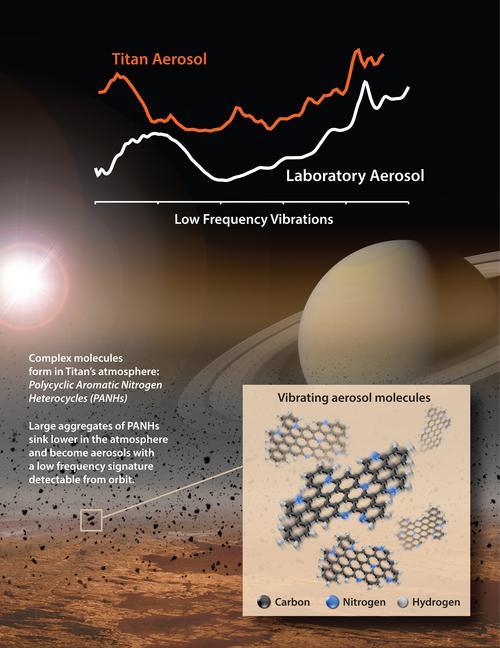
The diagram above shows the formation and the dynamics of Polycyclic Aromatic Nitrogen Heterocycles or PANHs found in the orange atmosphere of Saturn’s largest moon Titan. Researchers have been able to produce an aerosol with a roughly similar spectrum to that of the aerosol identified in the Titanian atmosphere. Image source: NASA/Goddard/JPL-Caltech.
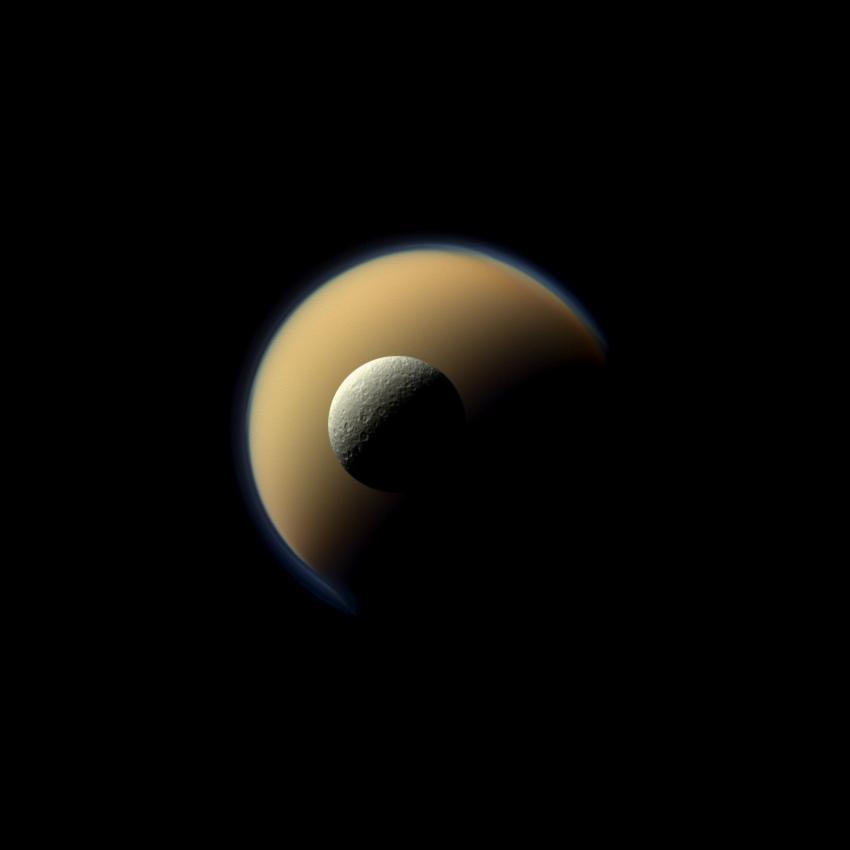
The view above, which shows the icy moon Rhea in front of Titan, reveals the complex atmosphere of Saturn's largest moon. A blue outer layer can be clearly seen in the atmosphere of Titan and the north polar region found in the upper right part of the orange disk is covered with a relatively bright layer marking a contrast with the rest of the atmosphere. The natural-color image was produced on the basis of images acquired using red, green and blue spectral filters. The views were obtained with the Narrow-Angle Camera of the Cassini spacecraft on June 16, 2011. Image Credit: NASA/JPL-Caltech/Space Science Institute.
- To get further information on that news, go to: http://saturn.jpl.nasa.gov/news/cassinifeatures/feature20140613.
May 28, 2014: Sunsets on Titan Allow Scientists to Study the Complex Spectra of the Upper Atmosphere of Titan and Exoplanets
The complex atmosphere of Saturn's largest moon Titan appears to be one of its most surprising characteristics. Most moons in the Solar System are devoid of any significant atmosphere. For instance, Ganymede, the largest moon in the Solar System, has no atmosphere.
The atmosphere of the Orange Moon Titan is opaque to visible light, deep, thick and dense. The atmospheric pressure on the Huygens landing site was recorded at 1467 hPa on January 14, 2005.
The observations of the Titanian atmosphere have shown how complex it is. The atmosphere is hazy with dynamic cloud systems in the polar regions and a complex upper atmosphere.
A group of researchers has studied the atmosphere of Titan during sunsets when the light from the Sun passes through the upper atmosphere of Titan allowing scientists to analyze the spectrum of light which goes through the atmosphere up to the observation device.
Researchers realize that the analysis of spectral data regarding hazy atmospheres is really complex. The analysis of atmospheric spectra on Titan during sunsets can help scientists better understand the spectra of exoplanets during transits provided that they are covered with a significant atmosphere.
The work on the spectral analysis during sunsets on Titan was carried out by a team of scientists led by Tyler Robinson, a NASA Postdoctoral Research Fellow at NASA's Ames Research Center in Moffett Field, California and the findings were released on May 26 in the Proceedings of the National Academy of Sciences. Tyler Robinson pointed out: "It turns out there's a lot you can learn from looking at a sunset."
Spectroscopy is particularly complex but it can tell us a lot about the atmosphere of Titan, or about stars or extrasolar planets. The light emanating from the star is a mixture of different colors or different wavelengths and with a special device (a spectroscope), or a prism, you can decompose the light into its different colors or wavelengths to produce spectra which bring a large amount of information upon the characteristics of the object or the atmosphere.
Researchers can study exoplanets or the atmosphere of extrasolar planets thanks to transits when the light from the host star passes through the atmosphere of the exoplanet and reaches the spectroscope. The fact that the light from the star goes through the atmosphere of the exoplanet changes the spectrum of light we get and scientists can deduce numerous characteristics of the alien atmosphere such as the temperature level, the composition and the structure of the atmosphere.
Robinson and his collaborators have become aware of the complex effects of hazes on the spectrum of light they try to analyze during a solar occultation or a planetary transit. The configuration during sunsets helps them compare or analyze the atmosphere of Titan and the atmosphere of exoplanets but the task is hard.
Researchers can perform comparative analyses between the spectra obtained from exoplanets and the spectra of planetary bodies that are composed of a significant atmosphere in the Solar System and that we know quite well. The Gas Giants Jupiter, Saturn, Uranus and Neptune as well as the rocky planets Venus and Mars are composed of significant atmospheres whose spectroscopic analysis can help us better decipher the atmosphere of any exoplanet.
The presence of clouds or high-altitude hazes will engender particular spectroscopic signatures and if the atmosphere of a selected exoplanet has also clouds or high-altitude hazes, it may engender a spectrum with similarities to the spectrum of well-known atmospheres.
But once again, clouds and hazes generate a variety of complicated effects on the spectrum which make the analysis of atmospheres in other star systems particularly difficult. Scientists must face complexity and computing power to analyze the hazes. That's why researchers may rather use models to analyze or decipher exoplanet spectra in a less complicated way.
Tyler Robinson argued: "Previously, it was unclear exactly how hazes were affecting observations of transiting exoplanets."..."So we turned to Titan, a hazy world in our own solar system that has been extensively studied by Cassini."
The analysis regarding the spectral characteristics of Titan's atmosphere is based on four observations of Titan performed between 2006 and 2011 by the Visual and Infrared Mapping Spectrometer of the Cassini probe. The team concluded that the hazes have complex effects on the spectrum and they are however in a position to compare the atmosphere of Titan with the atmosphere of exoplanets or with the models regarding exoplanets.
The team of Tyler Robinson also noticed that Titanian sunsets, solar occultations or transits mainly bring information upon the upper atmosphere of the moon or planet, due to high-altitude hazes in particular.
In other words, the spectra of the atmosphere can only bring information upon the upper layers of the atmosphere. The portion of the Titanian atmosphere which can be analyzed using the sunset technique corresponds to the upper atmosphere from approximately 90 to 190 miles or 150 to 300 kilometers above the surface. The richest parts of the atmosphere such as the Troposphere or the lower atmosphere where evaporation and precipitation occur can't be analyzed with this technique.
The team of Tyler Robinson also found that hazes on the Opaque Moon more strongly affect shorter wavelengths, or bluer, colors of light. That's not what had been concluded for the studies of extrasolar planet spectra which used to assume that hazes would have similar impacts on all colors of light. As a result, the Sunset technique for Titan has allowed researchers to get a better idea on the interaction of light with the atmosphere and on its consequences on the way the spectrum appears for the light of the Sunset or of the solar occultation.
Mark Marley, a co-author of the analysis at NASA Ames pointed out: "People had dreamed up rules for how planets would behave when seen in transit, but Titan didn't get the memo." He added: "It looks nothing like some of the previous suggestions, and it's because of the haze."
Scientists will need to deepen their study of the atmosphere of other Solar System bodies in order to better analyze the atmospheres of exoplanets. We have a significant sample of bodies with an atmosphere in the Solar System, from Titan to Neptune, Triton or even Pluto. Curt Niebur, Cassini program scientist at NASA Headquarters in Washington insisted: "It's rewarding to see that Cassini's study of the solar system is helping us to better understand other solar systems as well."
The composition or structure of any atmosphere appears to be closely related to temperature factors and gravity factors. The atmospheres of rocky bodies like the Earth, Mars and Venus are often composed of carbon dioxide or nitrogen whereas the atmospheres of Gas Giants in colder environments are often composed of hydrogen, helium and methane. The atmosphere of Titan is mostly made up of molecular nitrogen and methane.
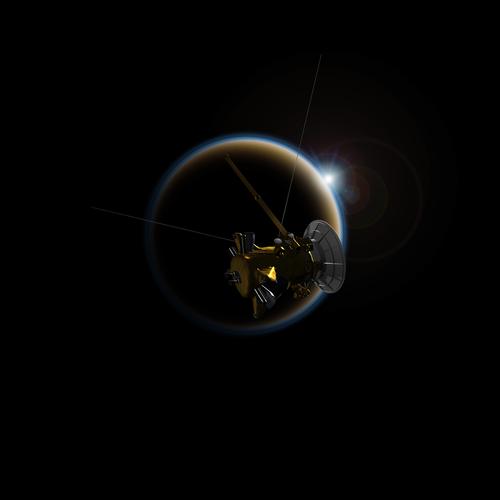
The artist's rendering above reveals a sunset on the Opaque Moon Titan from the Cassini spacecraft. The Sun appears here through the upper atmosphere of the hazy moon. The upper layer of the orange atmosphere appears blue. Scientists have analyzed data obtained from the Visual and Infrared Mapping Spectrometer of the Cassini probe during sunsets and have been in a position to simulate spectra of the Opaque Moon as if it were a planetary transit, a configuration when a planet passes in front of a distant star from the observation point. The study of sunsets on Titan allows scientists to better understand data received from exoplanets with hazy atmospheres. Image Credit: NASA/JPL-Caltech.
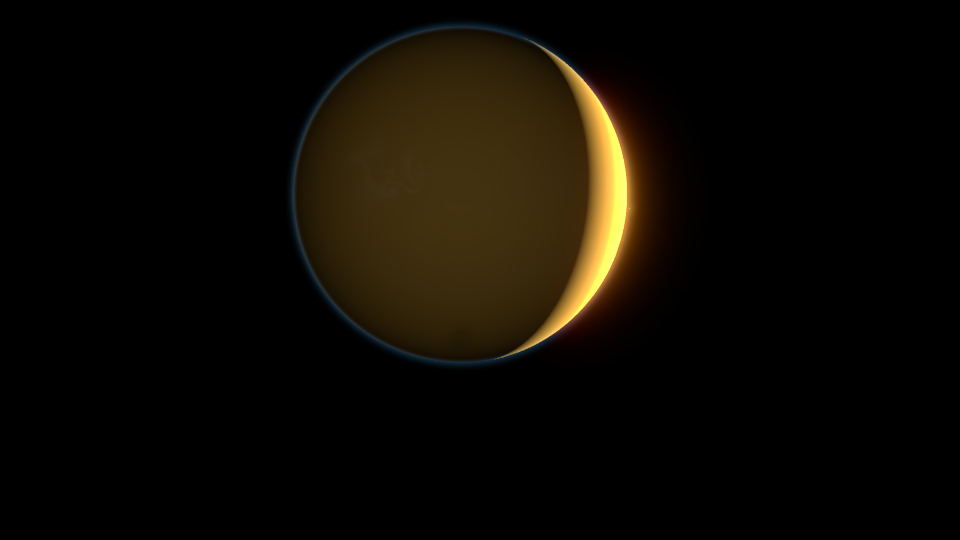
The artistic view above shows Saturn's largest moon Titan during a sunset configuration. In this simulated representation, the Orange Moon whose diameter is 5 150 km is found approximately 14 924 km from the observer whereas the Sun, whose diameter is 1 392 684 km, is found approximately 1 433 464 294 km from the observer. The apparent diameter of the Sun from the observer, which appears as a bright dot to the right of the Orange Moon, is only about 0.06 degrees whereas the apparent diameter of the Opaque Moon here is about 19.77 degrees. This sunset configuration allows researchers to gather precious information upon the hazy atmosphere and in particular upon the upper atmosphere. Image Credit: Marc Lafferre, 2014.
- To get further information on that news, go to: http://saturn.jpl.nasa.gov/news/newsreleases/newsrelease20140527.
March 21, 2014: Researchers May Have Identified Small Waves in the Smooth Lakes or Seas of Titan
For the first time, scientists may have gathered clear signs of waves in the lakes or seas of Titan's northern hemisphere. Two reports on the finding were presented at the Lunar and Planetary Science Conference on March 17, 2014.
The first report was presented by Jason Barnes, a planetary researcher at the University of Idaho in Moscow. Jason Barnes reveals that the Cassini probe captured, in 2012 and 2013, several unusual glints of sunlight off the surface of Punga Mare, one of the major bodies of liquids in the north polar region.
Those particular reflections may result from small ripples, no more than 2 centimeters high, that emerge from an extremely flat and smooth lake or sea as Jason Barnes notes. The exact nature of the liquids in the north polar lakes or seas is still unknown but scientists suggest that they may be likely dominated by a mixture of methane and ethane. Some other hydrocarbons such as propane and dissolved nitrogen may also be present in the lakes or seas.
Kraken Mare is, by far, the largest surface body of liquids in the northern hemisphere and even on the entire moon. Punga Mare appears to be a little smaller than Ligeia Mare, the second largest pool of liquids in the north polar region. Surprisingly, the north polar region is the dampest area of Titan with a pleiade of lakes or seas. Ontario Lacus is the only significant lake or sea in the south polar region.
The dichotomy in the distribution of lakes or seas between the southern hemisphere and the northern hemisphere may be related to seasonal factors. The amount of surface liquids may be higher during the Winter period than during the Summer period because there is more condensation of hydrocarbons during the Winter period.
The Winter period in the northern hemisphere and the Summer period in the southern hemisphere came to an end in August 2009. The Spring season in the northern hemisphere is now advancing toward the Summer season. In parallel, the Autumn season in the southern hemisphere is progressing toward the Winter season.
Each season is particularly long since it lasts about 7 Terrestrial years. As a result, a Titanian year lasts approximately 29 Terrestrial years. During that period, the distance between the Saturn system and the Sun can vary significantly in the elliptical orbit of the Saturn system around the Sun.
Scientists suggest that the winds in the northern hemisphere are going to become stronger as the Spring season advances and as the Summer season in the northern hemisphere develops in the coming Terrestrial years. As a result, they anticipate more waves or stronger waves in the lakes or seas of the north polar region.
Ralph Lorenz, a planetologist at the Johns Hopkins University Applied Physics Laboratory in Laurel, Maryland pointed out: "Titan may be beginning to stir."..."Oceanography is no longer just an Earth science."
As soon as 2010, Ralph Lorenz had been one of the scientists who proposed the idea that the winds would strengthen as the Spring season develops in the north polar region and as the energy of the Spring season and of the Summer season increases. The rise in the wind speed is supposed to engender waves or stronger waves. And it may become easier for scientists to spot waves as the Spring season in the northern hemisphere develops.
Researchers are trying to understand why it has been so hard to identify waves in the north polar lakes or seas which seem to appear almost as smooth as a mirror. Several possibilities have been advanced to account for this remarkable smoothness. In fact, the liquids whose exact composition is unknown may be particularly viscous, more viscous than water.
Therefore, the lakes or seas may be extremely flat like an oil field or a tar field since the high level of viscosity limits the movement of the liquid. There may also be a thin layer of organics or hydrocarbons forming over the underlying liquid. The winds may be too weak to engender waves or ripples in the lakes or seas, as well.
Punga Mare was observed with a spectrometer of the Cassini probe several times during 2012 and 2013. The views revealed sunlight glinting off the surface of the dark lake Punga Mare. Jason Barnes advanced, at the conference, that four pixels in the views are brighter than one might expect from reflecting solar radiation. He inferred that there must be something particularly rough in the area and a wave or a set of waves may account for this apparent roughness.
The calculations suggest that the height of the waves may represent a few centimeters. That's very low! Jason Barnes insists: "Don't make your surfing plane reservation for Titan just yet." The physical characteristics of the waves and of the surface of the pools of liquids may represent significant clues for our understanding of the nature of the liquids.
It is also important for the design of a future lander toward the north polar lakes or seas. Jason Barnes pointed out: "If we drop a lake lander in there, is it going to splat instead of splash ?" Scientists will try to identify the presumed waves of Punga Mare again in future observations if the spacecraft is in the right position. The glints or the reflections may also be related to a mudflat or a wet or solid surface. Nothing is really certain.
Punga Mare is not the only lake where some bright reflections associated with waves have been spotted. Another report at the conference reveals some clues for the presence of ripples or waves in Ligeia Mare, the second largest pool of liquids in the north polar region. Last Summer, Cassini planetologists identified a bright reflection in one image of Ligeia Mare. This bright spot was not visible 16 days later or in any images acquired since as Jason Hofgartner, a planetologist at Cornell University in Ithaca, New York pointed out.
This bright patch had been called the "magic island". Why did it vanish ? Is it related to an increase in the lake level ? The team favors the idea that the glint or the bright reflection results from a set of waves or a group of bubbles going up from the interior of the lake. But the bright patch could also be an iceberg. Another observation of the area will be performed from the Cassini probe during a future flyby in August. Waves or iceberg ? We will see!
In parallel of the finding upon waves, a team led by Howard Zebker, professor of geophysics and of electrical engineering at Stanford, in collaboration with Ker Than, presented a new finding upon Ligeia Mare published online in Geophysical Research Letters. On the basis of radar data obtained from the Cassini probe in 2013, the team concluded that the surface of the dark Ligeia Mare is as smooth as a mirror, probably due to a lack of winds.
Howard Zebker reported: "If you could look out on this sea, it would be really still. It would just be a totally glassy surface." The team also found that the solid terrain surrounding the lake or sea is likely composed of solid organic materials rather than frozen water.
Scientists are trying to better understand the interactions between Ligeia Mare, the atmosphere and the underground. There is a complex meteorological cycle related to seasons with rainfall, evaporation and condensation phenomena. Howard Zebker advanced: "Titan is the best analog that we have in the solar system to a body like the Earth because it is the only other body that we know of that has a complex cycle of solid, liquid, and gas constituents."
To illustrate how the radar system works, he explained: "If the lake were really flat, it would act as a perfect mirror and you would have an extremely bright image of the sun."..."But if you ruffle up the surface of the sea, the light gets scattered in a lot of directions, and the reflection would be much dimmer. We did the same thing with radar on Titan."
Let's imagine that Ligeia Mare which is about 260 miles or 420 km long and 217 miles or 350 km wide represents a perfect plane. Howard Zebker argued: "Cassini's radar sensitivity in this experiment is one millimeter, so that means if there are waves on Ligeia Mare, they're smaller than one millimeter. That's really, really smooth."
How to explain this remarkable smoothness ? The team advances several hypotheses. First, at the time of the observation, the wind may have been too weak. Second, there may be a thin upper layer preventing any wave action. Howard Zebker pointed out: "For example, on Earth, if you put oil on top of a sea, you suppress a lot of small waves."
The analysis of measurements performed regarding microwave radiation emitted from the materials surrounding Ligeia Mare, taking into account temperature and pressure factors, confirmed previous conclusions that the terrain surrounding Ligeia Mare is made up of solid organic material, likely the same ethane and methane that can be found in the lake or sea.
Howard Zebker pointed out: "Like water on Earth, methane on Titan can exist as a solid, a liquid, and a gas all at once." The study of organics and hydrocarbons on Titan appears to be crucial for our understanding upon the development of life on Earth.
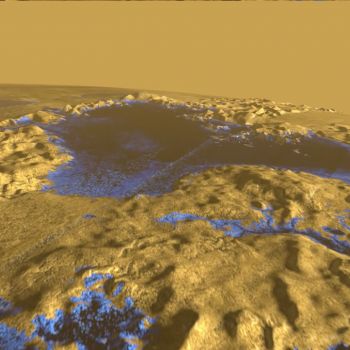
The false-color view above, proposed by Howard Zebker and representing the area of the dark et quiet lake Ligeia Mare, was generated on the basis of radar data obtained from the Radar Mapper of the Cassini probe. The observation suggests that the lake is extremely flat or smooth and that the winds are weak in the area. Image Source: Courtesy of Howard Zebker.
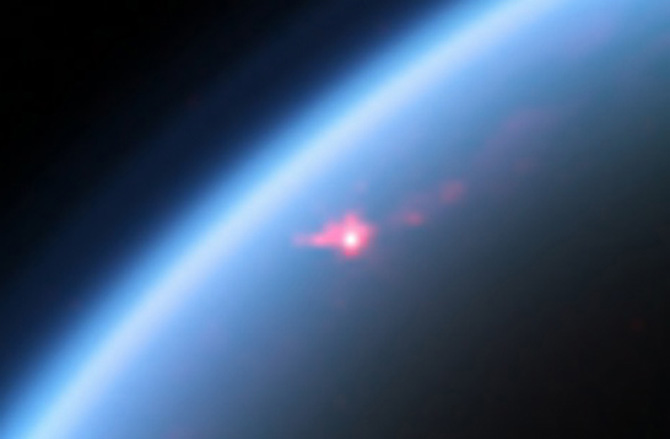
The image above, obtained from the VIMS of the Cassini probe on July 24, 2012 during the T85 flyby, reveals a glint or a reflection in the area of Titan's north polar lakes and seas. This reflection may be the outcome of ripples or waves. Image Credit: NASA/JPL-Caltech/SSI/Jason W. Barnes et al.

The image above corresponds to an artist's representation of a particularly quiet and smooth lake in the north polar region of Saturn's largest moon Titan. The liquid of the lakes and seas of the north polar region may be relatively viscous accounting for the remarkable smoothness observed so far. Image Credit: Marc Lafferre, 2014.
- To get further information on that news, go to: http://www.nature.com/news/first-hints-of-waves-on-titan-s-seas-1.14889 and https://pangea.stanford.edu/news/surface-titan-sea-mirror-smooth.
Titan News 2013
Titan
News 2012
Titan
News 2011
Titan
News 2010
Titan
News 2009
Titan News 2008
Titan
News 2007
Titan
News 2006
Titan News
2004, 2005
